#Black women with a white parent included IF they identify as a Black woman and know they aren't white
Text
listen.
i am 100% being shady here.
pretty sure only people who aren't Black women like Katrina Crane.
there are probably a few exceptions.
but they weren't raised right 😭
i was not suprised to see Katrina fans on here, but they do not seem to be Black (the microagressions when talking about Abbie slay me)
we do use different tags for the show. i forgot ours was "shady hollow" and i ran into them for the first time on here.
y'all would have been eaten alive in 2015.
liking her is like, personal taste. she was designed to attract a different audience. this was to spite Nicole and the Black female fans to appease white conservative Fox watchers and the white Sleepy Hollow actors, but it's not like people know that going in.
they just see a character they relate to more because they are in the audience the show writers decided to cater to.
but tptb got their show canceled with Katrina the Struggle Witch and damn Betsy Ross.
also just killing off the characters of color and replacing them with white people and acting like it was the same show.
i never wanted a show to fail so bad.
and fail it did!
#shady hollow#and i do mean Black women#Black women with a white parent included IF they identify as a Black woman and know they aren't white#if you identify with white women Katrina is more appealing but not if you understand misogynoir#if the show was less racist she wouldn't have been a main character and used to “replace” the Black lead#you could tell when they switched over to having white writers#what a waste
0 notes
Text
"AMATONORMATIVITY" MAY BE REAL IN A WAY, BUT ITS PRIMARY TARGETS ARE NOT AROMANTIC PEOPLE
* Do not call me, the writer of this post, "allo" or "an allo" in any manner. I am a gay victim of CSA and repeated relationship abuse, and my relationship to romance and sex is shaped by a lifetime of trauma. If you trivialize me into your "allo boogeyman", my response will not be kind
I spent hours upon hours yesterday in the "amatonormativity" tag, reading blog posts from over a hundred individuals as well as longer entries structured as articles and even excerpts from published books - you can't accuse me of pulling a definition of "amatonormativity" out of my ass, because I approached it with great attention and made detailed notes to identify those characteristics of "amatonormativity" that are universally considered to be present and harmful, and to discard the personal opinions of more extreme individuals. It is not my intention to engage with people whose revulsion towards romance comes from a place of personal trauma, but to challenge and refute the seemingly VERY popular idea that there is a societal construct/axis of power present in *all of society* that forces *all people* to couple romantically, and that romantically coupled people hold innate power over lifelong singles.
...every single trait of "amatonormativity" that aro bloggers universally bring up can be attributed to a different, pre-existing oppressive construct. Mainly "amatonormativity" is a jumbled mix of patriarchal/misogynistic ideals, consumerism and white supremacy. Also, the supposed equation of amatonormativity falls completely into trash when you try to include mentally and physically disabled people, homosexual and transgender people, mainly.
Familial/peer pressure to find a partner is cited as a form of amatonormative abuse most often. However, this is plainly a patriarchal standard. People perceived as women and men alike are expected to pander to the patriarchy by partnering - women, because they are still valued mainly as objects of beauty and belonging, which is to say, romantic partners. Lifelong single women are not harassed because they are single, but because they are unavailible to men. You can see this being true because lesbians are pressured by their families to partner with men in the same vein acearo women are - if amatonormativity were real, f/f relationships would be generally seen as an acceptable happy end for a woman... but partnered gay and bisexual (in f/f relationships) women still face abuse ranging from pressure to turn to dating men, invasive questions about their relationships, conversion therapy, corrective rape, forced marriages, violence and murder. Don't try to say "but my family would rather I date a woman than no-one at all!". If it's so, you are one in a million, and even then you surely have relatives and friends who think the opposite. Believing that a woman needs a (male) partner to be fulfilled is not "amatonormativity". It is misogyny.
As for men, they are pressured to find (female) partners in order to take their "rightful" place within the patriarchy. This is not "misandry" by the way - this is an extension of women being perceived as a man's right. A man who does not have a woman is perceived as lesser because of patriarchal standards, and is seen as emasculated and unable to wield patriarchal power. Likewise, homosexual and bisexual (in m/m relationships) men are not accepted by society just because they are partnered. They face violence, vitriol and mockery on a worldwide scale. Your parents are not asking you if your friend of the opposite gender is your partner & "who do you have a crush on" because of "amatonormativity" - they are doing so because of patriarchal expectations.
The idea of a nuclear family and monetary benefits to having one is also often cited as amatonormativity. But *the concept of a nuclear family was pushed as an antiblack political move, primarily to target Black single mothers and families that do not fit a white western ideal*. It is a racialized construct, and first and foremost a tool of white supremacy. Though nonblack singles also suffer the unfair tax brackets and marital expectations, they are not its primary targets, and if anything are proof that white people are willing to sacrifice even the more misfortunate of their own for a sliver of a chance to hurt and control Black citizens. This is antiblackness, not "amatonormativity".
The third problem, the one i see cited alongside the first two even though I do not consider them to hold equal weight, is the oversaturation of media with themes of romance and sex, celebration of Valentine's day, couples' merchandise and so on. *This is just consumerism*. Romance and sex sell so they will produce more romance and sex to sell more. It's lame, and I am against the trivialization of love in order to sell it as a cheap product. I empathize with the fact that the media you love is filled with cheap romance, because I'm not a huge fan of the genre and am especially uninterested in m/f romance. But this is not an unique struggle. You can argue that m/m and f/f relationships have been gaining more representation in media, but this is largely because companies figured out that they can make money off of them. Gay media largely does not exist because gay love is celebrated and valued. *It is a product to sell*. Gay couples in media are not "amatonormative" - they are facets of consumerism or gay artists' yearnings (and those aren't aimed at hurting you, and aren't the real issue).
Lastly... how can you claim that the pressure to partner is universal, when eugenics and marriage inequality exist? Mentally disabled people - autistic people with support needs, people with learning disabilities, speech impediments, personality disorders - we are all purposefully desexualized and deromanticized as well as demonized or infantilized for the sake of preventing us from partnering and reproducing. *This is ableism, and its goal is to isolate and exterminate disabled people from society.* Physically disabled people are desexualized and infantilized to an even higher degree, people whose appearances reflect their disability are demonized *and most prominently, people lose their disability benefits if they get married. This is eugenicist violence, and its goal is to weed out disabled people from society.* Where is "amatonormativity" now? Disabled people are not even allowed to dream of partnering.
And the gays you blame for reinforcing amatonormativity and forcing their love upon you? *In many places, gay and bisexual people are systemically encouraged to be celibate through religious abuse*. A gay person remaining celibate is deemed as virtuous! When I came out to my mother, she told me that she could accept my inclinations "so long as I don't commit physical sin". Gay people are not encouraged to partner. Never have been, never will be. Gay people also face medicalization of our orientation, conversion therapy, forced marriage and corrective rape. Gay people also have straight standards shoved down our throats. But we are not your oppressors. Gay love is encouraged exclusively in gay circles, and if you condemn our expression of our love that has always been repressed and demonized, don't cry when you make enemies here.
What about transgender people? Transgender people - especially transgender woman - are painted by cisheteropatriarchy as sexual deviants, as predators looking to corrupt. They are not encouraged to partner - no, not even transhets. They are deemed unloveable. They are wanted alone, miserable, and then dead. Where is "amatonormativity"?
In conclusion, the idea of "amatonormativity" stands on legs so shaky they can't be called legs. What you are trying to isolate is actially an intersection of the cisheteropatriarchy, white supremacy and capitalist consimerism. I understand that aromantic people face difficulties, I do. I understand you feel frustrated and want a simple construct to make an enemy of. But you can't dismantle "amatonormativity" alone because it is a delicate net of far more complex axes of power. Focus your strength on dismantling the patriarchy, white supremacy, ableism and capitalism. When women, gay and trans people, Black people and other people of color and disabled people are free, no one will turn on you so long as you don't shoot stray bullets in your pointless war on romantic love.
Feel free to respectfully comment and offer your differing opinions, because I really want this discussed.
29 notes
·
View notes
Text
crying again out of happiness for megan because she's been through so much. so much. and i know i'm older than her by a few years but i look up to her. i really do. and i've been though shit myself and i always just quit my job after reporting the abuse, because every time i would report, a black woman in power would defend the black man i reported that did the abuse. and use their connections to the christian church to do it.
and i read that the parents of fucker that shot megan were in the court room screaming about the system being wicked and unjust because their son was convicted of shooting megan.
and i need y'all to understand that happens more often than you'd think. and people are so quick to say oh someone's mommy and daddy got them off and that's why white boys don't get in trouble for breaking the law, and i need y'all to know that ALL races do that.
i've seen it. i've cried with other girls who are not my race (i'm black) that have seen it with their own eyes.
it's a problem. too many nonwhite people keep saying it's not fair that their nonwhite sons are being punished for crimes because white people aren't. and that's not how ANYTHING should work.
i want ALL people who commit crimes against others to be held accountable for their actions. that include people with my own skin color. and it sickens me to my fucking CORE that i have to say that. that anyone has to say that.
it's heartbreaking being a black woman and hearing your community say well the white guy didn't get in trouble, so why should our black men get in trouble. they have it hard enough.
that is fucking sick on so many levels.
i pray every day for megan and all of us who have suffered abuse and harm from men in our own communities. i pray that we all heal and get justice one day.
and i pray for our journey towards healing be safe.
please stand up for black women. please stand up for women. this includes trans women because i know how y'all work on social media and i fucking REFUSE to leave out my girls who are like, girls. like i hate i have to add this at the end of posts i write because so many are like "ahh not those TRANS" and i'm like... you're a fucking idiot because i said women. and that included people who identify as women you fucking moron.
anyways thank you megan for not allowing the hate to get you down. and i hate that we've both wanted to die after being abused by men in our communities because our community chose to protect the abuser over believing us.
may the goddesses always protect you megan and may you find peace here on this earth now even though we don't know what we're up against especially as black women, and know you're so loved by so many of us. from the bottom of my heart, i am so proud of you and you give so many of us courage to keep speaking out, even through tears.
thank you. <3
180 notes
·
View notes
Text
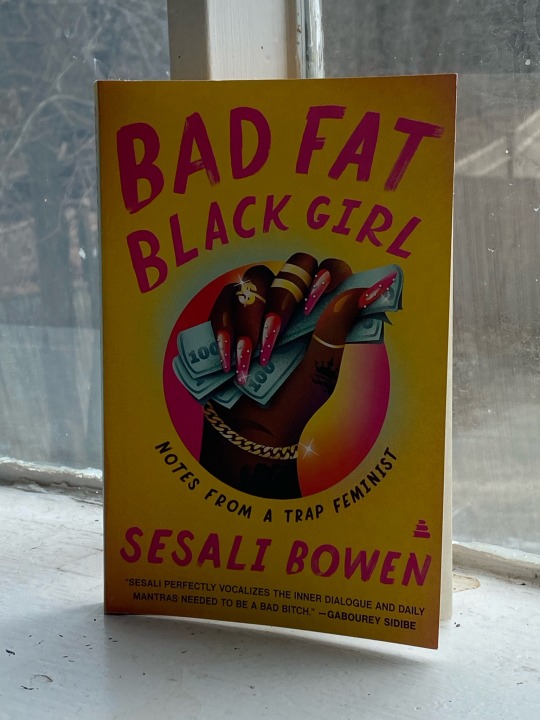
I appreciated reading this book. Another book about feminism, yet with a Black perspective. Not only a Black perspective, but from a voice of someone who identifies as a Fat Black Queer Woman. I don’t necessarily identify myself in that way, but I loved how this author spoke true on how she navigates in this world. Speaking the truth in acknowledging and embodying our intersectionality. Who knew there is such a thing called Trap feminism. If trap feminism means I can be me without giving 2 f**ks of what others think of me…sign me up!
I am a Christian Black Feminist Demisexual Woman who is intelligent, independent, compassionate, and adventurous who is also a counselor, a storyteller, an advocate, a prayer warrior, and a bookworm who loves her music and probably the realest person you’ll ever meet.
HERE ARE MY TAKEAWAYS:
“Generally speaking, Black people do have a higher tolerance for body fat on feminine bodies than other groups do. But thick and fat are not the same thing. White beauty norms will always find themselves a seat at the table, even ours, and that includes vicious fat phobia.”
“For those of us who are most marginalized, beauty actually becomes a tool that can be used to defend ourselves against racism, sexism, transphobia, classism, etc.”
“Multiple studies have concluded that Black women and girls have higher rates of self-esteem and confidence than other female groups. Confidence is waiting on the other side of choosing to keep it real with yourself, choosing to heal some shit, choosing to humble yourself.”
“Maintaining your standards means saying no to people, places, and things that don’t serve you.”
“Economic mobility is a bit of a myth in that it’s often dangled in front of Black folks as the key to a better life, but without context, nuance, or a blueprint.”
“Our bodies are heavily surveilled and our behaviors unfairly policed out of fear that we will misuse our sexuality. We’re expected to protect ourselves from abusers, and it’s us who are held accountable when we are abused. We’re denied the right to innocence before we’re old enough to know what it means.”
“Our own internalized anti-Blackness has led us to believe that Black excellence comes only in the form of heterosexual marriage, kids, and wealth building. Because our survival as Black folks in Westernized culture often depends on our ability and willingness to succeed under these moral codes, we’ve embraced those heteronormative, binary rules and incorrectly processed them as part of some natural order.”
“ The reasons and methods used to shame Black women for their choices in sex, dating, and relationships are endless. Black women can no longer afford to be martyrs, healers, parents, or scapegoats in our relationships. I’M NOT A THERAPIST, A BUSINESS MENTOR, A LIFE COACH, OR A CRISIS MANAGER. I AM NOT TAKING ON ANY OF THOSE ROLES TO DATE SOMEONE. I WANT A LOVER, NOT A JOB.”
“Friendship is how you get really good practice in empathy, healthy conflict resolution, and to build and be in community. It’s how you learn to appreciate community so that you’re not headed into your other relationships expecting one person to be your everything.”
#life lessons#black feminism#lgbtq community#confidence#booklover#bookstagram#grown and sexy#strong women#wisdom#black authors
3 notes
·
View notes
Text
Lone Women
Non-spoilery: I wanted to like this, and the blurb made me think I really would, but boy is this book equal parts mind-boggling, boring, and pandering. It makes PERFECT sense to me that most people who have read this got a free copy or a Book of the Month copy.
Spoilery:
OY and also GEVALT. Jesus herschel Christ, okay so, first of all this book is a textbook example of what I’m talking about when i say sometimes representative fiction and media risks becoming a Pokemon ‘gotta catch em all’ situation. The story centers around a Black woman, Adelaide, which is fantastic and absolutely relevant to the story given that Montana was very “sure fine whatever” about giving Black homesteaders land. But then, it just...keeps adding up. Another Black woman and a Chinese woman who are also lesbians, obviously, and lesbianing together join up with Adelaide and her new friend, a single mother with a young trans son that she is 100% accepting of. This is in a 250ish page book, and at a certain point you just start sighing because it’s this author is just ticking stuff off a list at this point. This would be very doable in a longer book or maybe a better written one, but this is a piece of genre fiction par excellence, and none of that is on offer here, so you end up just trying to figure out how he’s gonna shoehorn in another minority. Because none of these minorities have problems with each other, by the way. Obviously. There is no such thing as inter-minority oppression and hatred, there is “majority” and “minority” and the white straight people who are the villains are truly mustache twirling in a way that is damn near hilarious. I think that actually identifies a big problem: None of these characters feel like people. I was sitting here thinking about having read and interacted with MANY other properties that play the ‘gotta catch em all’ game, and as a person who can often be included in ‘em all’ I am often not bothered, but the issue here is none of them FEEL like more than the Minority Experience he has highlighted for each of them. The villains have no internal life. Everyone is the flattest possible version of what a person can be.
That’s all very truly annoying, but I think I could forgive it if the horror was good. I have forgiven MUCH MUCH bigger sins in other books because the horror was enjoyable. Please don’t let the above make you think I am discerning in my horror tastes.
But oh my god. what the fuck.
The whole story centers around Adelaide having this secret she keeps locked up in a trunk with her. It’s heavy and burdensome, but she MUST carry it with her. It contains a murderous thing, a thing that killed her parents, and she dreams of being free of it. It nearly kills a man she falls in love with, and he goes away. Sounds great, right? Me sitting here wondering what I think this whole thing could be a metaphor for, for generational trauma or what have you. When it killed some mean white people I thought maybe it was a metaphor for Black anger. It’s a faceless monster described only in terms of its sharpness and its lust for men and horses (which did throw my theory about black anger out the window.)
But, at the end, it turns out the thing she’s been carrying around was born at the same time as she was and is, I shit you not, a literal dragon. Lavalle has intentionally avoided ever calling it a dragon throughout the book, I suppose because he thinks this twist is exceptionally clever. The dragon is Adelaide’s sister, and the secret is for her to learn to love her sister and also after they beat the bad guys--where, it must be said, they attempt to hang the lone women on the stage of a grand opera house-- everyone goes and lives in a secret town for “lone women” where everyone gets to be happy.
I read that, reread it, and quietly uttered “What the fuck”
I would be much angrier about it if I were a slow reader, but I’m not, so I don’t care. Read this if you’d like to read a book that feels like a bold attempt to cash in on people’s desire for representation in stories that also understands very very little about racial and social politics in the American West, which unfortunately I know a lot of, and also the big twist is SHE IS CARRYING AROUND A LITERAL DRAGON WHO IS ONLY DANGEROUS BECAUSE IT DOESN’T GET LOVE.
12 notes
·
View notes
Text
Texas is going to spend more on this guys surgery than they would on an actual woman.
US — Dallas, Texas. The United States Bureau of Prisons (BOP) will fast-track the “gender confirmation” plastic surgery of a genocidal Neo-Nazi commander and serial bank robber who sued the government after a previous request for the surgery was denied.
In a June 17 status report, the BOP agreed to act to “quickly” meet the “surgical needs” of Peter Kevin Langan, a male inmate who identifies as a woman named Donna Langan.
Langan, 64, is serving a sentence of life in prison plus 35 years for convictions in 1997 on five counts of Bank Robbery, Using An Explosive Device During A Robbery, and charges related to an assault on a federal officer with a pistol. After nearly two decades in a male prison, Langan was moved to Federal Medical Center, a correctional facility for women in Carswell, Texas, under Obama-era federal guidelines.
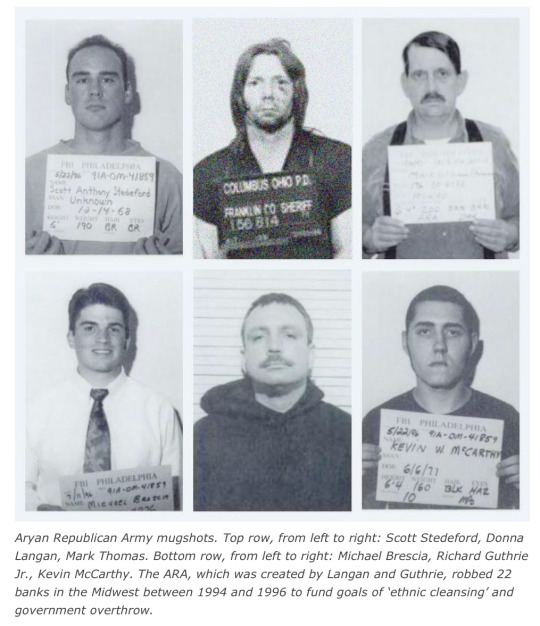
Genocidal Machinations In 1992, Langan had joined with friend Richard Guthrie to create the Aryan Republican Army (ARA). Under the alias Commander Pedro, Langan schemed with cohorts to carry out an “ethnic cleansing.” Lengthy propaganda videos recorded by the ARA contained anti-government, anti-black and anti-Jewish rants, and called for acts of terrorism. The gang amassed an assortment of weaponry and gear, including pipe bombs, guns, a rocket launcher, gas masks, bulletproof vests, getaway vehicles, police scanners, pagers, phone cards, walkie-talkies, phony IDs, hotel rooms, safe houses and storage lockers.
To finance its “nuclear, chemical and biological warfare program,” the ARA robbed 22 banks across seven states from 1994 to 1996, which net the gang over $250,000. Life & Crimes The son of a foreign aid official, Langan had a privileged childhood in a Saigon, Vietnam community made up of US intelligence agents and military advisers. His parents, who were Scottish and Irish, had callers of all racial backgrounds during the family’s traditional holiday open house. The boy’s father died when he was aged nine.
A hippie during his early teens, Langan marched for peace and brotherhood. The youth’s life of crime began at age 15 after he dropped out of Wheaton High School and ran away from home. Law enforcement shot the teen in the leg that year as he attempted to flee apprehension for a robbery. During the five-year prison stint, Langan became a white separatist.
In the years following his release from prison, Langan failed at university, a marriage and holding a job. As the struggling handyman and divorced father-of-one watched his siblings thrive, he began to feel “the world was against him,” a close friend said. While living with girlfriend Faith Ford, an IRS employee who identified as a “white Christian,” the disgruntled man began stockpiling weaponry, gathering guns and 10,000 rounds of ammunition. He also dressed his small son in military camouflage.
At around the age of 29, Langan tried his luck in Ohio, where he converted to Mormonism and was ordained minister at a church affiliated with the Ku Klux Klan.
In 1993, Langan was arrested in connection with a robbery at a Pizza Hut in Georgia that he committed with Guthrie the prior year. The duo made off with just $1800, but Langan also faced weapons violations carrying the potential for a life sentence.
The Secret Service agreed to set Langan free if he helped them catch Guthrie, who made threats against then-President Bush around the time the duo robbed Pizza Hut. Six weeks following release, Langan skipped out on the deal. With Guthrie, Langan launched a bank robbery spree that would go on for two years.
In 1995, Guthrie’s wild antics concerned the gang, and they cut him out of bank robbery jobs. Going solo, Guthrie robbed two banks before he was captured by the FBI.
In January 1996, Guthrie led federal agents to Langan’s dwelling. The FBI fired at Langan’s van 46 shots in 10 seconds, but he emerged relatively unscathed. Guthrie was allowed to plead guilty to 19 bank robberies in exchange for testimony against three ARA accomplices.
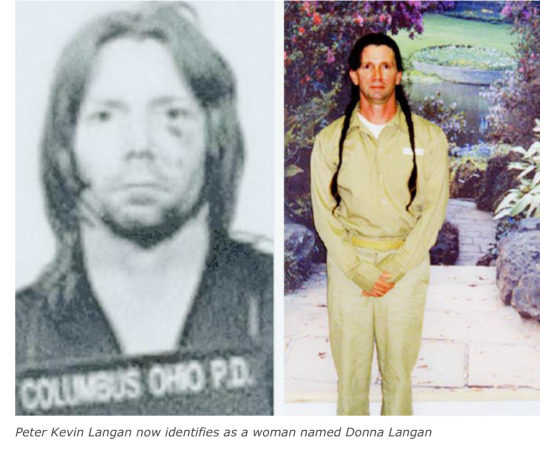
‘Gender Dysphoria’ During Langan’s 1997 trials, revelations that the ARA commander was in a sexual relationship with a man, and that both identified as ‘pre-operative transsexuals’, sent shock waves through the media. “She is my soul mate and we are lovers,” Mishka Alexander Jackson, who also used the alias Cherie Roberts, told the press. Showing off a silver band on his ring finger and a ring with a large stone that hung around his neck, he claimed to have met Langan at Crossdressers and Friends in Kansas years earlier, and become his life partner.
Langan, now responding to the name of Donna, “dressed as a woman and assumed the female role” in the relationship, his paramour revealed. The dramatic paramour burst into tears when a US Marshal stopped him from approaching his “wife” in the courtroom. The Washington Post marveled at the “prissy”-looking Langan, who showed up at trial with “dyed, flowing hair and long, carefully tended fingernails” and looking nothing like the “hardened thug” federal agents said he was. The paper implied Langan was acting.
After over two decades in prison, Langan joined two other transgender-identifying male convicts in mounting a legal challenge against Texas Family Code 45.103, which prohibits a person with a felony conviction from changing their name while in custody and within two years of release.
The men, who named Governor Greg Abbott and Attorney General Ken Paxton in the joint complaint filed December 4, 2019, argued that being denied a name change while “transgender” constitutes “cruel and unusual punishment.”
Langan told the Trans Pride Initiative at the time: I need the legal name change for many reasons, practical as well as to help affirm who I am now. To change the sex on my birth certificate I also need to have a name change to a gender appropriate name, as well as the surgery, and it will help in the approval process towards my surgery. I have gone by Bella Donna or just Donna for over 24 years, I have been forced to use my legal name many times and many people when they want to harass me they call me by my legal name to try and get under my skin or to make me mad. I have tried many times over the years but local laws and or the cost has prevented me from being able to do so. The inmates have not managed to overturn the Texas law, but Langan has won the privilege to undergo the cosmetic surgery he demands.
In a September 2021 complaint against the BOP, Langan claimed to be experiencing “debilitating anguish as a result of severe and inadequately treated gender dysphoria.” Langan said he knew by the age of four that he “had been misidentified as a boy,” and that his “entire life has been shaped by the agonizing tension between the immutability of her gender identity and the often life-or-death danger of publicly living” his “truth.”
#Dallas#texas#Neo-Nazi transwoman#Man in women’s prison#Male getting cosmetic surgery#Actual women in prison have trouble getting access to adequate menstrual care products
85 notes
·
View notes
Text
Unlock Financial Empowerment for LA Women

A Comprehensive Guide to Financial Freedom
Los Angeles, the city of dreams, is not just a hub for entertainment and culture but also a challenging financial landscape, especially for women navigating the complexities of income disparity, high living costs, and the quest for financial literacy. "Empowering Women's Financial Journey in Los Angeles" delves into the unique financial hurdles and opportunities women face in this dynamic city, offering a roadmap to financial empowerment and success.

The Financial Landscape for Women. Photo by Hannan. Flickr.
Understanding the Landscape: Challenges and Opportunities
Los Angeles presents a paradox of vast opportunities shadowed by significant financial challenges for women. The income gap is a glaring issue, with women in LA County earning 28% less than their male counterparts, translating to a significant $16,000 annual shortfall.
This disparity widens for Latina and Black women, who earn 47% and 34% less than white men, respectively. Moreover, financial literacy remains a hurdle, with a mere 38% of American adults considered financially literate, and women scoring slightly lower than men on assessments.
The cost of living in Los Angeles only compounds these challenges. With an overall cost of living 57% higher than the national average, and housing costs consuming 44% of median household income, the financial strain disproportionately affects women, particularly those who are single parents or bear a larger share of household expenses.

Smart Saving Strategies for Every Woman. Photo By Hannan. Flickr.
Building the Roadmap: Practical Steps Towards Financial Empowerment
Starting with the Basics
The journey to financial empowerment starts with mastering the basics. This includes budgeting, tracking expenses, and effectively utilizing resources like free credit reports and financial management apps. Creating a budget and vigilantly monitoring expenses serve as foundational steps. These steps empower women to take control of their finances, identify areas for adjustment, and set achievable, realistic goals.
Boosting Income and Career Development
Exploring career development opportunities, engaging in side hustles, and honing negotiation skills for pay raises are crucial strategies for women to boost their income. Los Angeles offers myriad avenues for career advancement, from professional development workshops to networking events tailored to women’s career growth.
Demystifying Investing
Investing remains an underutilized tool for financial growth among women, with only 30% identifying as individual investors. Demystifying investment options like stocks, bonds, and mutual funds, and providing accessible resources for learning can bridge this gap. Empowering women with knowledge and confidence to invest can significantly impact their financial futures and contribute to closing the gender investing gap.
Navigating Debt Management
Effective debt management strategies, including consolidation methods and the snowball/avalanche approaches, are essential for financial health. Moreover, connecting women with debt relief programs and resources can guide them through the process of managing and overcoming debt, thereby paving the way for financial stability.

LA hotel receptionist at work. Photo by Rodrigo Salomon HC. Pixabay.
LA-Specific Resources: Tailored Support for Women
Los Angeles is home to numerous organizations and programs designed to support women's financial empowerment. From the Los Angeles County Department of Consumer and Business Affairs offering free financial literacy workshops to the Chicana/Latina Foundation providing scholarships and grants for Latinas, the city is rich with resources aimed at aiding women in their financial journeys.
The YWCA of Greater Los Angeles further supports economic security through financial literacy programs, job training, and childcare assistance.
Charting a Path to Financial Empowerment
In Los Angeles, where its unique blend of challenges and opportunities prevails, a tailored approach to financial empowerment for women becomes essential. It encompasses various stages, from comprehending the basics of financial management to exploring diverse investment avenues and strategically leveraging local resources. This multifaceted journey leads to financial independence.
"Empowering Women's Financial Journey in Los Angeles" serves as a beacon of hope, illustrating that with the right knowledge, tools, and community support, achieving financial empowerment is not just a dream but a reachable goal for women in the City of Angels. This journey is not just about securing financial stability but also about building a confident, empowered community of women who are ready to take on the world.
Sources: THX News & Wikipedia.
Read the full article
#careerdevelopmentLosAngeles#debtmanagementstrategies#financialchallengesLosAngeleswomen#financialempowermentLosAngeles#financialliteracyforwomen#investingforwomenLA#LAfinancialresourcesforwomen#smartsavingstrategiesLA#womenfinancialindependenceLA#womenincomegapLA
0 notes
Text
Tumblr Blog Post 1 Art 150
Black-ish is a television show that details the lives of an African American family as they are growing up in a majority white neighborhood. The parents, Rainbow “Bow” Johnson and Andre “Dre” Johnson lead the family as they face tough encounters involving issues such as race, police brutality, biracialism, and many more. In this course, we have looked at media, whether it be video, audio, or picture to see how each depicts a “narrative” of cultural, ethnic, and racial identity in the United States. The television show Black-ish is no different. In watching the show, the audience views a modern “narrative” of what cultural, racial, and ethnic identity means to each of the members of the Johnson family through their eyes. The parents even give history lessons when they address each issue, utilizing cartoon type imagery to drive their point home to the younger, typically generation Z viewer.
In the show, the character of Rainbow highlights the topic of being mixed-raced and biracialism, a subject we discussed in class. This is addressed as early as the first episode. Rainbow’s father is white, and her mother is African American. When her son brings home a white girlfriend, Rainbow is forced to face her own biracial identity and the historical implications around it: https://twitter.com/i/status/804158363449769984. As discussed in class and in the clip of the episode, the demographics of the United States is growing in mix-raced population.

This is represented in this image, which uses slight variation of hue to demonstrate a critical point: with this growth comes an “identity crisis” as Rainbow calls it for mix-raced and biracial people. The clip I included from the episode employs the use of expressive faces and slight raunchiness to emphasize how biracial people historically have endured quite polarizing results with being accepted by African Americans among others as African American. It took until the Civil Rights movement for them to get the green light to identity as such. The intensity of the topic combined with the expressive imagery causes the viewer to call into question what it means to identify as multiracial.

(Loving Vs. Virginia Case)
The Civil Rights movement was one of the first steps in transforming the very definition of what it means to be African American (in the context of biracialism), and throughout the show Black-ish does so as well. Additionally, this episode explores the intersectionality of being a biracial woman, bringing gender into the conversation. The episode hones in on the idea that white women in biracial partnerships are viewed (by often men) as superior to biracial African American women. This mixture of a racial and gender hierarchy is an idea we explored in class. For instance, in Ringlero’s “Prairie Pinups,” Ringlero discusses and includes images of half-naked Native American women that were taken and sold to white men. Not only were these women discriminated against because they were Native American, but they were furthermore exploited due to their gender. This parallels the additive gender, ethnicity, and racial hierarchy illustrated in Black-Ish.
works cited:
Duignan, Brian. “Loving v. Virginia.” Encyclopædia Britannica, Encyclopædia Britannica, Inc., 8 Nov. 2022, https://www.britannica.com/event/Loving-v-Virginia.
Fusco, Coco, and Brian Wallis. Only Skin Deep: Changing Visions of the American Self. International Center of Photography in Association with Harry N. Abrams, Inc., Publishers, 2003.
Ross, Tracee Ellis, director. Blackish. Twitter, Twitter, 1 Dec. 2016, https://twitter.com/TraceeEllisRoss/status/804158363449769984. Accessed 4 Dec. 2022.
Wang, Hansi Lo, et al. “Painting by Numbers.” NPR, NPR, 20 Oct. 2021, https://www.npr.org/2021/09/29/1041510105/painting-by-numbers.
1 note
·
View note
Text
𝐑𝐀𝐍𝐓 #𝟑: Female Public Figures Dating Men with Questionable Views That Contradict Their Image & Alleged Politics
𝗗𝗜𝗦𝗖𝗟𝗔𝗜𝗠𝗘𝗥: These rant blog posts are really just reflective of my thoughts at the time that I make them and are posted here because I need an outlet to release all of this shit I have going on my busy ass mind. That’s it and that’s all. Now let’s get into it..
This rant was greatly inspired by none other than Ms. Robyn Rihanna “Tell Your Faves To Pull Up [in regards to social injustices directly affecting black people]” Fenty and her openly colorist boyfriend, A$AP Rocky. Aside from the fact that Rihanna tends to slip under the radar and is never held accountable for her problematic ways due to her conventional beauty (i.e. Her heavy usage of anti-Asian slurs, particularly targeted towards Chris Brown’s ex gf, Karrueche), it’s very alarming that a woman who has an entire makeup brand with a campaign based around the inclusivity of ALL black women is publicly flaunting a beau who once said that DSBW do not look good with red lipstick.
And yes, I’m very much aware that Rakim said this tasteless comment over 8 years ago but from the looks of it, not much has really changed with him. Don’t @ me about it neither because I don’t care.
Also peep how he compares a hypothetical darkskinned woman to a man (Wesley Snipes) while trying to explain how his antiblackness isn’t wrong because he said something about white women as well. Gaslighting at its finest. Don’t you just love it! 😀
Furthermore, you would think that somebody of Rihanna’s level of stature would know not to associate themselves with someone as messy as A$AP Rocky but... Stupid is what stupid does, I guess! I can’t even begin to place the blame on him anymore because he’s revealed his true colors and we all have made the deliberate choice to either accept it or don’t and have discontinued all support for him. Unfortunately, misogynoir is never the dealbreaker for most people and the hatred for [dark-skinned] black women is so engrained in society that it’s frowned upon when we publicly speak out against it. Very ass backwards if you ask me but that’s society for you. Now, enough about that. Let’s focus back on Ms. Vita La Coco.
As a woman who claims to be a girl’s girl and is always presenting herself to be someone who is the epitome of a pro-black feminist bad ass, it just makes her alleged activism come off so disingenuous when she’s also laying down with the same man that actively attacks the demographic she’s supposed to be standing in solidarity with. It’s “Black Lives Matter” on the IG posts but your vagina is getting moist for a man who openly stated he doesn’t relate to what goes on in Ferguson because he lives in Soho & Beverly Hills. Ferguson being the exact place where a 17-year-old black boy’s lifeless corpse laid on the hot concrete for FOUR hours after he was murdered by a police officer. He couldn’t 'relate' to the fate of so many black men, women, and children who are murdered or seriously injured from state-sanctioned violence because they’re poor and he is not or so he thought.
But then again, what can I really expect from a woman who identified as being “biracial” until as recent as roughly 6 years ago? What can I really expect from a woman who called Rachel Dolezal a ‘hero’ for cosplaying as a black woman? I’d be lying if I said my expectations for her were high in this regard because sis has always shown us she was lacking in this department. And just for the record, this is not a personal attack on Rihanna at all for the die-hard Navy stans in the back. I admire her latest fashions and bop my head to her music just like the next person but she’s getting the side-eye from me on this one.
Trust and believe me though, she’s not the only woman who I can call out for being a hypocrite. Of course not! This stone can be cast at a few others. So without further ado, why don’t we bring Ms. Kehlani Parrish to the front of the congregation? Prior to Kehlani’s recent declaration of identifying as a lesbian, her last public relationship with a man was with YG. Yes, the same YG who felt it was necessary to say him & Nipsey had ‘pretty light-skinned’ daughters to raise in the middle of his deceased friend’s memorial. By the way, Nipsey’s daughter is not even light (or at least not in my book anyways.) She’s a very deep caramel tone just like her father which makes what he said even more moronic. Yes, the same YG who thought it was clever idea to use slavery as an aesthetic for a music video to a diss track about 6ix9ine. And yes, also the same YG who has derogatory lyrics targeted at bisexual women. Just to end up sweating the red carpets with one. I swear the jokes just continue to write themselves.
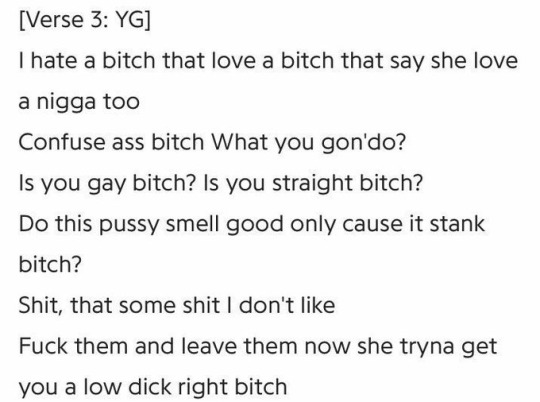
This raises the question once more; How high of a pedestal can I really put a multiracial woman who has a song titled ‘N*ggas’ and when received backlash for the song in question, she used the ultimate ‘I’m mixed’ copout while not having a visibly black parent in sight?
It’s also kind of suspicious to me that many were not privy to Kehlani’s secret romance with Victoria Monét (pictured bottom right) until Victoria did an interview with Gay Times revealing she fell in love with a girl but they subsequently broke up because Victoria had a boyfriend and that girl was pregnant in a polyamorous relationship. Fans began to speculate because both Victoria & Kehlani previously candidly spoke about their sexual orientations, Kehlani had just had Adeya and they both were seemingly close. Their short-lived fling would later be confirmed when Victoria released the song ‘Touch Me’ on her last project and Kehlani hopped on the remix. Meanwhile, Kehlani’s relationship with Shaina (pictured bottom left) was very overt and all over her Instagram feed from my recollection. And as you can see, Shaina looks absolutely nothing like Victoria. They look like the complete opposite of eachother in every aspect which is kind of alarming(?) to say the least because why is it that the women she proudly claims as her partners tend to have a very racially ambiguous look such as herself but her ‘sneaky links’ on the other hand are undoubtedly black women? Again, it could just be me jumping conclusions. You know, I’m kinda good for that however something tells me I’m not. Y’all be the judge of the material though.
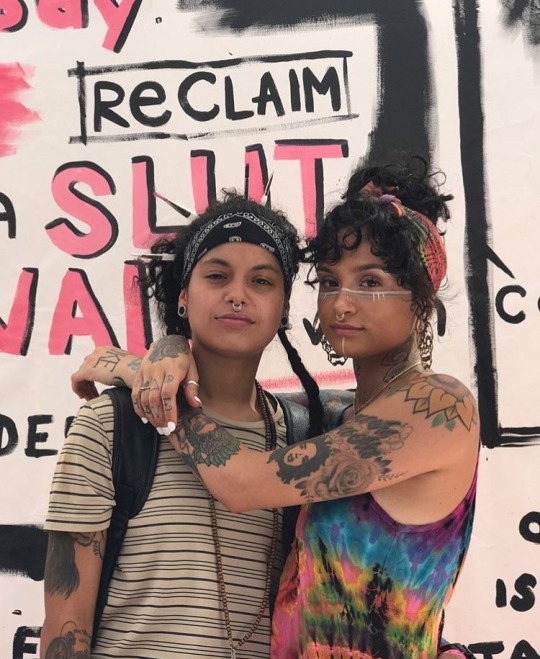

Last but not least, I’d like to touch on Ms. Raven Tracy very briefly. I was very weary about even including in this segment and if I should just put her in a entirely separate blog post with other women who openly date abusers despite their checkered past (alongside Nicki Minaj & her r*pist murderer of a husband, India Love & Sheck Wes etc.) being this particular blog post was based around the theme of lightskinned/mixed women dating men with extremely problematic views about DSBW. Raven obviously isn’t lightskinned or mixed however I refused to ignore how contradictory her [former] relationship with an alleged (I used this word very loosely and mainly for legality purposes.) serial r*pist while promoting a brand that is all about feminism & body positivity. This also traces back to A$AP Rocky by default being that Ian Connor is his very close friend and he came to Connor’s defense when several women came forward detailing accounts of Connor allegedly s*xually assaulting them. (I wish I could place the actual video of what A$AP Rocky said verbatim but Tumblr only allows one video per blog post. 🙄)
Back in June of this year, Ian & Raven had a back & forth on Twitter after Ian tweeted about Raven “fucking everybody” behind his back. I can only assume that he was alluding to Tori Brixx posting a video of her ex, Rich the Kid & Raven kissing on her story. Disgusted is not even the word to describe my feeling when she admitted she stuck by Ian despite of his many allegations of s*xual abuse because she loved him and her being a empath causes her to want to help everybody. Imagine aiding and abetting a predator and even paying for his bail & legal fees just to turn around and expect sympathy because this same individual cheated on you and exploited you all over Twitter for the public to see. The same man that you would get back with not even a WEEK after the fact & turn off your IG comments because it isn’t our “business” after making it our business...

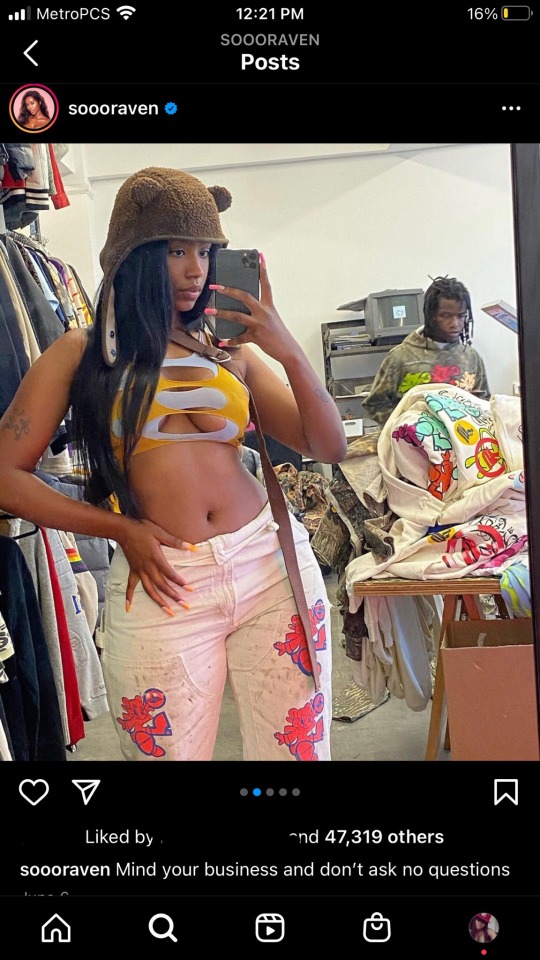
That being said, I just genuinely want to know: Why do these women completely go against what they stand for in regards to these men? Maybe it was never genuine from jump street and if that’s the case, why jump on the bandwagon of performative activism? Is it because it’s profitable right now? Is it because disrespecting black women is not an immediate death sentence to your careers and more often than not actually helps you advance even further? I guess that’s the billion dollar question that’ll never truly be answered. I just want the world to stop using black women as their stepping stool to get to where they need to go and then discarding of us when we’re no longer beneficial. Support us all the way or don’t support us at all. We deal with enough disrespect as is so we’d appreciate if y’all would stop straddling the fence and partake in your misogynoir out loud if that’s what you choose to do. We have no use for fake allyship and quite frankly, it’s doing more harm for us than good. Please and thank you!
Sincerely,
- 𝙼𝙸𝚂𝚂 𝙴𝙳𝙶𝙰𝚁 𝙰𝙻𝙻𝙴𝙽 𝙷𝙾𝙴. 💋
#i’m finally done after having this sitting in the drafts for about a good month... or two. 🥴🥴#abuse apologists#pro black#activism#feminism#body posititivity#colorism#raven tracy#kehlani#rihanna#yg#asap rocky#rant#my uploads.
211 notes
·
View notes
Text
On Sunday, 19 top administrators of the San Francisco School Board condemned the 2016 tweets from the board's Vice President Alison Collins
The officials said the tweets 'perpetuate gross and harmful stereotypes and leave no room for nuance or potential misunderstanding'
Their statement addressed Collins' tweets that she shared on December 4, 2016
In thread, Collins explained that she was seeking to 'combat anti-black racism in the Asian community' and at her daughter's mostly Asian American school
Collins said Asian Americans used 'white supremacist thinking to assimilate'
The entire senior staff of the San Francisco schools has denounced a black school board member's tweets that claimed Asian Americans use 'white supremacist thinking' to get ahead.

On Sunday, 19 top administrators at the district's central office condemned the 2016 tweets from the board's Vice President Alison Collins, according to the San Francisco Chronicle.
The city's top elected officials including its mayor, nearly all city supervisors and the area's state legislators all called for Collins to resign - but she hasn't.
The school officials said the tweets 'perpetuate gross and harmful stereotypes and leave no room for nuance or potential misunderstanding'.
Their statement addressed Collins' tweets that she shared on December 4, 2016
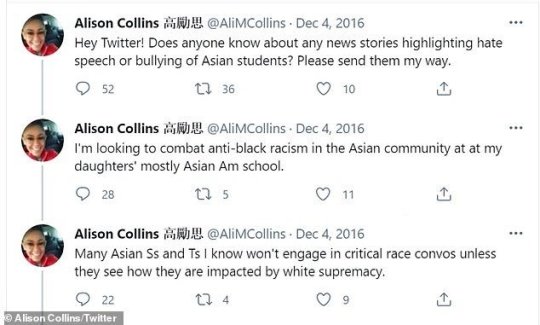
The officials said the tweets 'perpetuate gross and harmful stereotypes and leave no room for nuance or potential misunderstanding'. Their statement addressed Collins' tweets that she shared on December 4, 2016
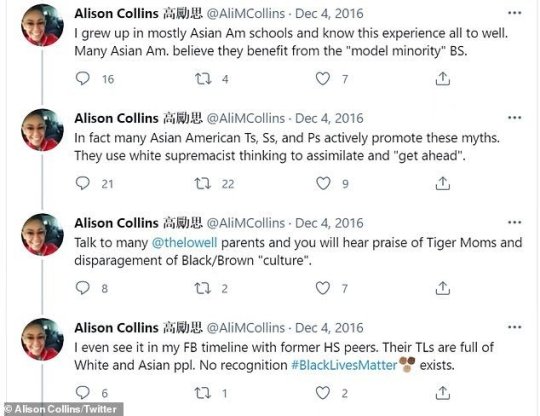
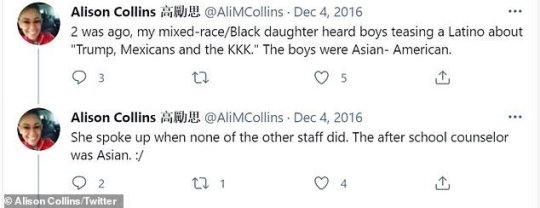

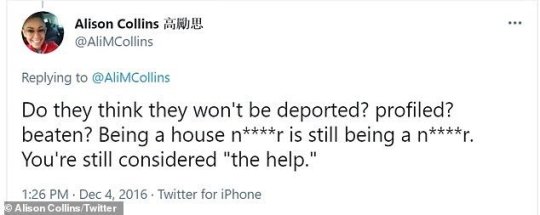
In the thread, Collins said that she was seeking to 'combat anti-black racism in the Asian community' and at her daughter's mostly Asian American school.
Collins said that Asian Americans had used 'white supremacist thinking to assimilate and "get ahead."'
She also included a reference comparing Asian Americans to 'house n***ers'.
'Where are the vocal Asians speaking up against Trump? Don't Asian Americans know they are on his list as well? Do they think they won't be deported? profiled? beaten? Being a house n****r is still being a n****r. You're still considered "the help,'" she tweeted at the time.
Collins has not resigned from her position and would not return calls from the San Francisco Chronicle on Sunday. Instead she directed people to an op-ed she wrote that was published on Medium in which she claimed her past statements were taken 'out of context.'
'A number of tweets and social media posts I made in 2016 have recently been highlighted. They have been taken out of context, both of that specific moment and the nuance of the conversation that took place,' Collins tweeted on Saturday with a link to her article.
A fellow board member, Jenny Lam, called the post a 'non-apology.'
The controversy comes as San Francisco’s school board has been slammed recently for voting to rename 44 of the city’s schools that were alleged to have insensitive names. The person in charge of the renaming effort admitted he researched the topic on Wikipedia and didn't consult historians.
In January, the board voted 6-1 to strip the schools of their current monikers because they honor 'racist' figures from American history. Schools named after politicians including George Washington, Thomas Jefferson, and Abraham Lincoln are now set to be rebranded in the coming months.
Meanwhile, a gay white father of a bi-racial child was denied a spot on the San Francisco Board of Education's volunteer parent committee in February because his race doesn't bring enough diversity to the group.
And the district of 52,000 students has been in a bitter dispute with unions over re-opening of the schools, which have been closed since the height of the coronavirus. Some schools will open April 12, but it’s not clear how many.
Collins, the school board's vice resident, said in the Medium posting that 'as a Black woman, a mother, an educator and a fierce advocate of equity in our schools I utilize my social media platforms to speak out on race and racism. Even when these conversations are difficult in our very divided society.'
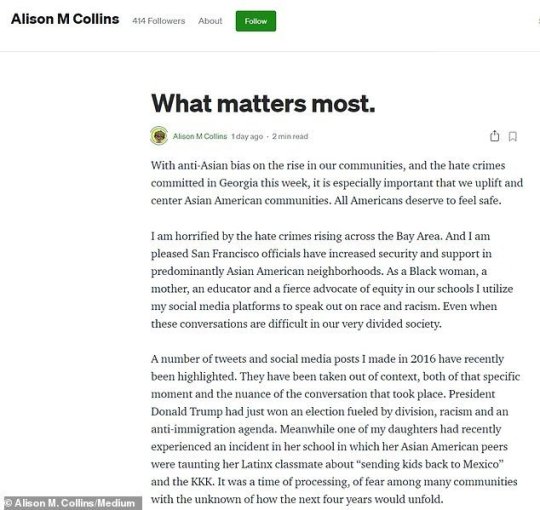
In the Medium piece, Collins wrote: 'As a Black woman, a mother, an educator and a fierce advocate of equity in our schools I utilize my social media platforms to speak out on race and racism. Even when these conversations are difficult in our very divided society'
In the post, Collins noted that then-President Donald Trump had just won an election when she made the remarks on Twitter
Meanwhile one of my daughters had recently experienced an incident in her school in which her Asian American peers were taunting her Latinx classmate about “sending kids back to Mexico” and the KKK. It was a time of processing, of fear among many communities with the unknown of how the next four years would unfold,' Collins wrote.
'But whether my tweets are being taken out of context or not, only one thing matters right now. And that is the pain our Asian American brothers and sisters and siblings are experiencing. Words have meaning and impact.
'Trump showed us that clearly with his sowing of hate and pitting communities of color against one another for political gain. I acknowledge that right now, in this moment my words taken out of context can be causing more pain for those who are already suffering. For the pain my words may have caused I am sorry, and I apologize unreservedly.
'What matters more than anything is showing up and supporting Asian American communities and victims of hate crimes. Let me be clear: I stand with the Asian American community against acts of violence. I have spoken with leaders in the Asian American community over the last 24 hours and I acknowledge the pain they are feeling,' she added.
Collins' tweets resurfaced just days after eight people, mostly Asian women, were shot dead in Atlanta, Georgia.
Police in Atlanta are still investigating suspected gunman Robert Aaron Long's motive in connection with the shooting on Tuesday. The Federal Bureau of Investigation is assisting with the investigation.
All eight deceased victims have been formally identified as: Delaina Ashley Yaun, 33; Paul Andre Michels, 54; Xiaojie Tan, 49; Daoyou Feng, 44; Soon C. Park, 44; Hyun J. Grant, 51; Suncha Kim, 69, and 63-year-old Yong Yue.
Meanwhile one of my daughters had recently experienced an incident in her school in which her Asian American peers were taunting her Latinx classmate about “sending kids back to Mexico” and the KKK. It was a time of processing, of fear among many communities with the unknown of how the next four years would unfold,' Collins wrote.
'But whether my tweets are being taken out of context or not, only one thing matters right now. And that is the pain our Asian American brothers and sisters and siblings are experiencing. Words have meaning and impact.
'Trump showed us that clearly with his sowing of hate and pitting communities of color against one another for political gain. I acknowledge that right now, in this moment my words taken out of context can be causing more pain for those who are already suffering. For the pain my words may have caused I am sorry, and I apologize unreservedly.
'What matters more than anything is showing up and supporting Asian American communities and victims of hate crimes. Let me be clear: I stand with the Asian American community against acts of violence. I have spoken with leaders in the Asian American community over the last 24 hours and I acknowledge the pain they are feeling,' she added.
Collins' tweets resurfaced just days after eight people, mostly Asian women, were shot dead in Atlanta, Georgia.
Police in Atlanta are still investigating suspected gunman Robert Aaron Long's motive in connection with the shooting on Tuesday. The Federal Bureau of Investigation is assisting with the investigation.
All eight deceased victims have been formally identified as: Delaina Ashley Yaun, 33; Paul Andre Michels, 54; Xiaojie Tan, 49; Daoyou Feng, 44; Soon C. Park, 44; Hyun J. Grant, 51; Suncha Kim, 69, and 63-year-old Yong Yue.
140 notes
·
View notes
Photo



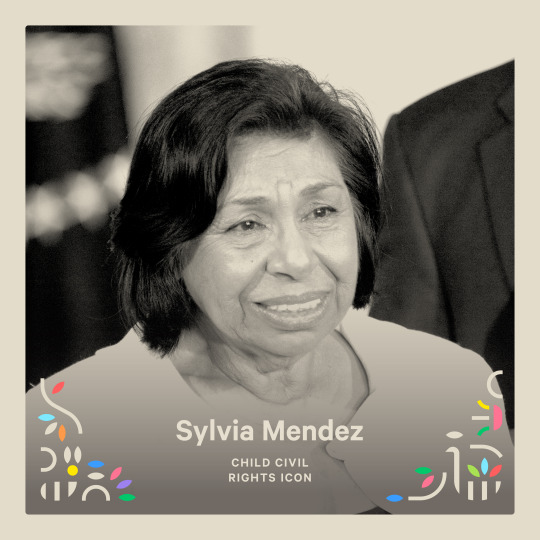


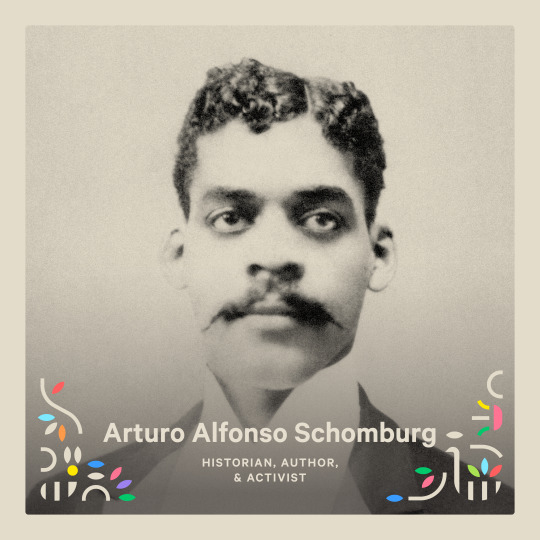
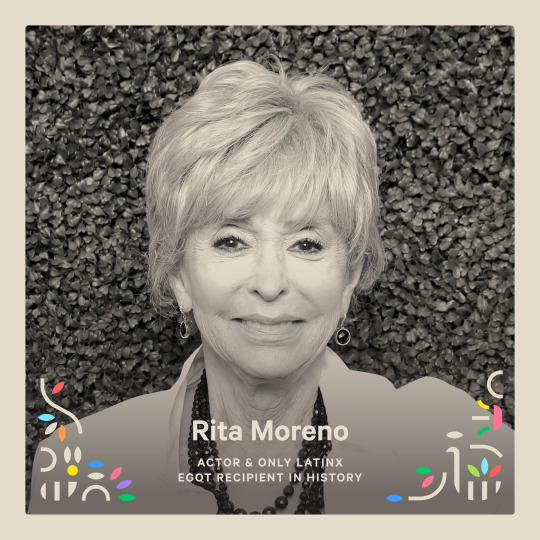
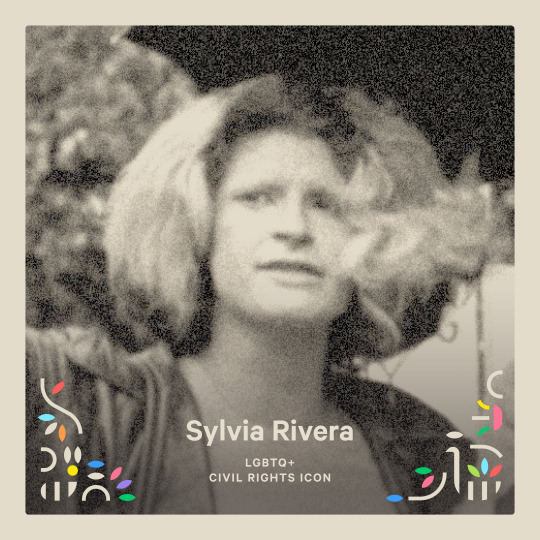
September 15 begins Hispanic Heritage Month — we’re kicking off the month by honoring a number of figures who historically have blazed a trail for the Hispanic American community
Fernando Valenzuela is a former MLB pitcher most famous for his time with the Los Angeles Dodgers from 1980-90. A Mexican immigrant, Valenzuela’s raw talent & colorful personality made him an instant hit with the Dodgers’ significant Latinx fanbase. The ensuing media frenzy became known as ‘Fernandomania’ and represented one of the first times in MLB history that a Hispanic player was a face of baseball. Valenzuela retired in 1997. In 2015, he became a naturalized American citizen.
Sonia Sotomayor is the first Latinx Supreme Court justice in U.S. history, having served since 2009. The daughter of Puerto Rican-born Americans, Sotomayor spent the bulk of her childhood being raised by a single mom in the Bronx, NY. Sotomayor graduated summa cum laude from Princeton in 1976 and earned a law degree from Yale Law School in 1979. Prior to being appointed to the Supreme Court by President Barack Obama, she was a federal judge for 17 years. Her SCOTUS tenure has been characterized by decisions emphasizing criminal justice reform and the civil rights of both defendants and minority communities.
Sylvia Mendez was just 8 years old when she became a civil rights icon. Growing up in 1940s California as the daughter of Mexican & Puerto Rican immigrants, Mendez was a central figure in the landmark 9th Circuit Court of Appeals case Mendez v. Westminster. The decision found that segregating Mexican American students into separate schools in California was unconstitutional and led to the desegregation of all public schools in the state. The arguments used in Mendez v. Westminster later served as a precursor for the 1954 landmark SCOTUS segregation case Brown v. Board of Ed. After childhood, Mendez went on to work as a nurse & a public speaker, and she was awarded the Presidential Medal of Freedom in 2011.
In 2015, Raffi Freedman-Gurspan made history as the first openly transgender person to serve in the White House in U.S. history. A longtime activist & expert on matters pertaining to LGBTQ+ civil rights and gender equality, Freedman-Gurspan was born in Honduras and raised by adoptive parents in Massachusetts. After graduating college in 2009, she pursued activism on the state level in MA for a few years before being hired as a policy adviser at the National Center for Transgender Equality. Her work focused on a number of issues impacting trans Americans, including homelessness, immigration, & incarceration. From there, she served 2 years in the Obama admin, first as an outreach & recruitment director and then as the White House’s LGBT liaison.
Ellen Ochoa is an icon for Latinx women in STEM. An engineer, astronaut, and former director of the Johnson Space Center, Ochoa made history in 1993 when she became the first Hispanic woman to travel to space while aboard the space shuttle Discovery. In her career as an astronaut, Ochoa logged approx 1,000 hours in space across 4 missions. Ochoa, who is a recipient of NASA's Distinguished Service Medal, was inducted into the U.S. Astronaut Hall of Fame in 2017.
Arturo Alfonso Schomburg (1874-1938) was an author, historian, activist, and leading intellectual of the Harlem Renaissance. Schomburg was an Afro Latino of Puerto Rican, Black, and German heritage. Over his career, he worked tirelessly to identify, document, and preserve elements of Black history & culture, including art, manuscripts, slave narratives, and other artifacts. The works he amassed are now a collection in the New York Public Library at the Schomburg Center for Research in Black Culture in Harlem. Schomburg was once quoted as saying, ‘Pride of race is the antidote to prejudice.’
At 88 years young, Rita Moreno remains a treasure of the stage and screen. She is the only Hispanic actor in history to complete the hallowed EGOT, having won an Emmy, Grammy, Oscar, and Tony award between 1962 and 1977. Her Oscar win, for the supporting role of Anita in 1961’s ‘West Side Story,’ remains her most iconic part. In recent decades, Moreno is perhaps best known for starring in the Netflix reboot of ‘One Day at a Time.’ In addition to her acting awards, Moreno has also been a Kennedy Center honoree and was awarded the Presidential Medal of Freedom in 2004.
Sylvia Rivera was an American icon of the early LGBTQ+ liberation movement, with a specific focus on activism for LGBTQ+ people of color and LGBTQ+ people experiencing homelessness. Together with her friend Marsha P. Johnson, Rivera was a fixture in New York City’s radical activist and cultural scene in the 1970s and ‘80s. Rivera & Johnson founded STAR (Street Transvestite Action Revolutionaries), a local collective that provided housing and aid to young LGBTQ+ New Yorkers at the time. Rivera, who was of Venezuelan & Puerto Rican descent, died in 2002 at the age of 50. In 2005, the corner of Hudson & Christopher streets in NYC’s Greenwich Village was renamed Sylvia Rivera Way.
follow @nowthisnews for daily news videos & more
725 notes
·
View notes
Text
New Queer Cinema
Starting from the late 1980s through early 1990s, a “new wave” of queer films became critically acclaimed in the film industry, allowing the freedom of sexuality to be featured in films without the burden of approval from the audience. This raw and honest film genre displays the truth, secrets, and vulnerability of the LGBTQ+ community and the representation that is deserved. The New Queer Cinema movement was started by scholar Ruby Rich who wrote “This movement in film and video was intensely political and aesthetically innovative, made possible by the debut of the camcorder, and driven initially by outrage over the unchecked spread of AIDS. The genre has grown to include an entire generation of queer artists, filmmakers, and activists.” (Rich) This movement started from Rich’s writing piece, not the filmmakers themselves. An article by Sam Moore discusses Rich’s start of the movement. He states, “Rich acknowledges that the films and filmmakers she considers under the umbrella of New Queer Cinema (including Todd Haynes, Cheryl Dunye, Isaac Julien, Gus Van Sant and Gregg Araki), don’t share a single aesthetic vocabulary or strategy or concern.” Instead, they’re unified by the ways that they queer existing narratives, subvert expectations and foreground queerness in material where it had been only implicit” (Moore). The journey through the New Queer Movement started with Ruby Rich defining the movement through her writing and inspiring filmmakers to continue producing movies with the correct representation.
Actress from Gone with the Wind Susan Hayward claimed that Queer cinema existed “decades” before an official title was given to the genre. French filmmaker Jean Cocteau created Le sang d'un poète in 1934 which is documented as one of the earliest Queer films. This avant-garde style of film is associated with Queer cinema filmmakers such as and is displayed in many upcoming films such as Ulrike Ottinger, Chantal Akerman and Pratibha Parmar. The influence of Queer theory that emerged from the late 1980s helped guide the movement with the creators. The theory states "Challenge and push further debates on gender and sexuality.” Another closely related statement by feminist theory states,"Confuse binary essentialisms around gender and sexual identity, expose their limitations.” Queer cinema filmmakers were sometimes known to depict their films in a “mainstream” way that is agreeable to the audience. There was no exposure to the truths and horrors that the LGBTQ+ community experience and had a lack of representation of historical elements or themes. The concept of “straightwashing” was described to filmmaker Derek Jarman’s 1991 historical film Edward II. This film received backlash from the LGBTQ+ community due to the film’s queer representation catering to heterosexuality and heteronormativity.
The truth of the movement was for Queer films to stop romanticizing or bringing positive images of gay men and lesbian woman. The push for authenticity and liberation for the community needed to be represented in films. New Queer films were more radical and sought to challenge social norms of “identity, gender, class, family and society.” (Wikiwand.com).
To quote the amazing drag queen of all time RuPaul “Everyone is born naked, and the rest is drag” the idea of gender identity and representation in the community is unlimited, why do you need to follow the norms of society when anything is possible? The late 90s documentary Paris is Burning introduced the audience to drag culture in New York City and the people of color who were involved in the community. The term “aesthetic” was repetitive in the research of New Queer Cinema which suggests the significance involved with the style of the films. The documentary includes the aesthetic of the drag world involving the makeup, fashion, and politics. AIDS activism was involved heavily in New Queer films and ridiculed the failure of Ronald Reagans acknowledgment of epidemic and the social stigma experienced by the gay community. Conservative politics occurred during this movement resulting in lack of media coverage and government assistance for the LGTBQ+ community. This political struggle did not discourage the community and the fight is still continuing today.
Beginning in the 2010s LGBT filmmakers Rose Troche and Travis Mathews created a “newer trend” in queer filmmaking that evolved toward more universal audience appeal. In an article from Wikiwand.com states,
“Rich, the originator of the phrase New Queer Cinema, has identified the emergence in the late 2000s of LGBT-themed mainstream films such as Brokeback Mountain, Milk, and The Kids Are All Right as a key moment in the evolution of the genre.[20] Both Troche and Mathews singled out Stacie Passon’s 2013 Concussion, a film about marital infidelity in which the central characters' lesbianism is a relatively minor aspect of a story and the primary theme is how a long-term relationship can become troubled and unfulfilling regardless of its gender configuration, as a prominent example of the trend” (Wikiwand).
The film Watermelon Woman was one of the first queer films I watched for a film class, and this film allowed me to dive deeper into the subject I care a lot about which is the representation of queer narratives about woman of color. Queer woman and men deal with the most discrimination. It is unfair and cruel to see the difference of racial treatment in the LGBTQ+ community because the backbone motto is full exclusion and equal rights. The film Watermelon Woman shined light on LGBTQ+ black woman and interrogated the “Mammy” stereotype that most films depict about black actresses. Minority narratives were pushed into the circuit of the movement with developed into the later academy-award winning film Moonlight that displays those representations makes film history!
Films to recognize in the height of the New Queer film movement are
Mala Noche (1986), Gus Van Sant, was an exploration of desire through the eyes of a young white store clerk named Walt and his obsession with a young undocumented immigrant named Johnny. The film is shot in black and white on 16mm film, contains many of the early Van Sant fixations that viewers would later see get refined in My Own Private Idaho, including male hustlers, illegality, and class.
Chinese Characters (1986), Richard Fung, this early film asks still-pressing questions about the nature of gay desire when it’s mediated via pornographic images of white men. The video defies genre, mixing documentary with performance art and archival footage to explore the tensions of being a gay Asian man looking at porn.
Looking for Langston (1989), Isaac Julien, this short film, a tribute to the life and work of Langston Hughes, is a beautiful and vibrant elegy. Julien creates a lineage of queer black ancestors for himself. The film moves like the poetry it recites, playing with the gaze and how various eyes look upon the black male body.
Tongues Untied (1989), Marlon Riggs, guided by the writer Joseph Beam’s statement, “Black men loving black men is the revolutionary act,” Riggs goes through his own complicated journey of homophobia from other black people, and then racism in the gay community, to find a community of queer black people.
Poison (1991), Todd Haynes, the three parts of the film tell a story about ostracism, violence, and marginality: the bullied child who allegedly flies away after shooting his father in order to save his mother (“Hero”), a brilliant scientist who accidentally ingests his own serum to become the “leper sex killer” (“Horror”), and a sexual relationship between two men in a prison (“Homo”). Exploits radical work that Haynes later uses in his other films.
The Living End (1992), Gregg Araki, the film follows Luke, a sexy homicidal drifter who has a distaste for T-shirts, and Jon, an uptight film critic in Los Angeles. Both are HIV-positive, and as their relationship unfolds, they fight about being respectful or lustrous.
Swoon (1992), Tom Kalin, a black and white film that romanticizes wealthy Chicago lovers kill a 14-year-old boy named Bobby Franks because they want to see if they are smart enough to do it. The murder is more a play of power between them, with Loeb weaponizing sex as a way to control Leopold.
Rock Hudson’s Home Movies (1992), Mark Rappaport, Rock Hudson’s Home Movies is a documentary made up of glances and innuendos from Rock Hudson’s persona, displaying how this dashing, leading man of the Hollywood Golden Age was a closeted gay man.
MURDER and Murder (1996), Yvonne Rainer, is known for her experimental filmmaking and choreography, this film represents a late-in-life lesbian named Doris who suffers from neuroses and breast cancer. Her partner, Mildred, a queer academic, tells the story of their romance as older women. Rainer also makes appearances throughout the film in a tux, going on rants about smug homophobic parents while showing her bare chest with a mastectomy scar.
1992 was the year of the highest amount of New Queer films being produced and exceeding box office expectations. Upcoming 2000s films such as “Booksmart”, “Call me by your Name”, “The Prom”, and “Rocketman” all represent the truths and authenticity of the LGBTQ+ community and creates pathways for more films to include these cinematic themes. The movement continues to grow and succeed in the film industry with new creators and actors being more honest about the LGBTQ+ community.




22 notes
·
View notes
Text
A Guide to Medieval Childhood
Our popular imaginings and depictions of medieval childhood tend to be somehow both scarce and bleak. It’s often supposed that childhood as a category didn’t really exist until the twentieth century, and that even the highborn children before that blessed time were regarded as basically inconvenient mini-adults until they were old enough to fight or marry, respectively.
The sources we have tend to favour the royal families and the high aristocracy with some wealthy merchants thrown in the mix, so, unfortunately, the information below would mostly be concerned with these groups - although I’m going to do my best to include some facts about the lives of children from lower social strata, too.

Infantia, or infancy
As Maria von Trapp used to sing in technicolor meadows, let’s start at the very beginning - it is, after all, a very good place to start.
A mother rarely gave birth unattended - and I’m not talking about medical professionals; more often than not, these would be represented by a sole midwife. However, having a close friend or a relative with you as you are waiting for the baby to arrive was a practice well-established by the early fourteenth century even among royal women, whose births, marriages and deaths alike were always ruled by strict ceremony.
In their case, as in the case of all great families of the land, the practice also had a purely pragmatic side - additional companions mean additional witnesses who would be able to swear, should a scandal arise, that the little heir really arrived in the lawful way and had not been, say, smuggled into the bedroom in a pan. (In the case of the British royal family this precaution eventually led to the Home Secretary being obliged to attend all royal births, and was only done away with in 1930, when the late Princess Margaret was born).
Of course, for all the companionable support, the birth was not without its risks - for the child even more so than for the mother. It was for that reason that, uniquely, the Church allowed the midwives to baptize newborn - or unborn - babies in case they don’t survive by the time the sacrament in question could be performed properly by a priest.
If everything went well, it was the time to prepare the child for an ‘official’ baptism in the local church, which was going to not only save his soul for the world to come, but to help his standing in this one - after all, being baptized in a particular church meant being integrated into the larger community of the parish. The mother could rest - she was not required to attend the christening (or, rather, she couldn’t, as she would only be able to enter a place of worship again after being purified via a brief ‘churching’ ceremony on the fortieth day after giving birth). The child’s godparents would have been there to stand in her stead.
In fact, many contemporaries considered that a woman needs at least a month to properly recover after birth. Nor was it supposed to be a time of solitude - receiving female visitors was both allowed and encouraged.
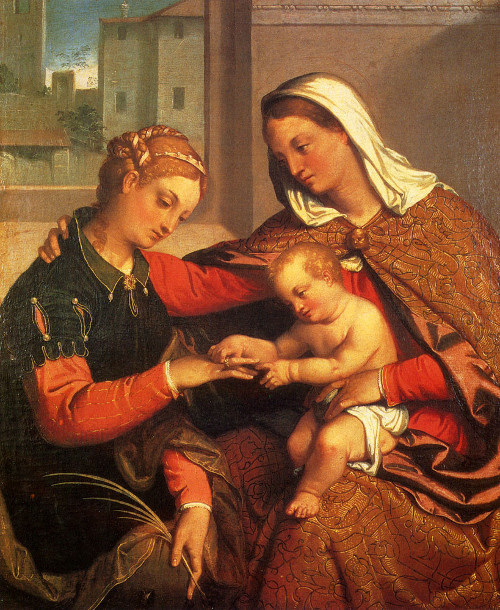
Meanwhile, the child would be transferred into the care of a wet-nurse. Breastfeeding your baby yourself usually signified that you simply cannot afford wet-nurse of good character. The good character part of the job description concerned itself both with the purely physical characteristics - the wet-nurse had to be a little below thirty, to have white teeth, sweet breath, and a child of her own not above eight months of age, otherwise her milk could be considered stale - and the moral ones. It was believed that virtues and vices both could be transmitted through milk, and thus it was imperative to choose a wet-nurse both sensible and respectable.
Once hired, she rarely left the baby’s side - contemporary writers acknowledged that leaving an infant to cry is harmful for the child’s health, both mental and physical, and therefore a nurse should always be at hand with either her breast or a lullaby. In the highest households of the land, such as that of the royal children of Henry VII and Elizabeth of York, one or two women were also employed as specifically the child’s rockers, tasked with, well, rocking their little charge to sleep - though not too quickly or too harshly, ‘for fear of making the milk float in [her] stomach’.
Every medieval baby, regardless of his family’s income, was swaddled from birth and until he was about eight or nine months of age: not only would he be kept warm, the parents judged, but it’s also going to help his limbs grow straight. A ‘breechcloth’ – essentially, a premodern nappy - was a piece of easily-washable linen, doubled over and then fastened into place with pins. Then a linen shirt would be gently placed over the infant’s body, after which the swaddling bands proper – sometimes three yards long – would come out. They were long, narrow pieces of – you guessed it - linen.
This swaddling part was universal for everyone; however, even here, before the child could partake in any fashion proper, the class divides came out to play. Babies from wealthier families could sport crimson mantles and bands decorated with gold embroidery (sometimes coordinated with that on their mothers’ outfits, like on the famous Cholmondeley Ladies painting at the top of this post).
Another – perhaps, more familiar to us – sphere of baby-related conspicuous consumption was the cradle. When, in 1494, the son of Beatrice d’Este and Ludovico Sforza was born in Milan, the proud father presented his guests a four-poster cradle covered in white satin, where the little heir now lay. When Lucrezia Borgia gave the d’Este family an heir, she splashed out on the cradle for the little Ercole even more. According to contemporary witnesses, the cradle was located under tent-like Moorish-style silk draperies done in the Este colors. It was on a platform encased in a great carved and gilded canopy, six feet long and five feet wide. The cradle proper was curtained in white satin, with the sleeping baby covered with cloth-of-gold.

The weaning tended to come, by our standards, rather late: some contemporary arguments recommended three years for boys and two years for girls (the former, after all, were expected to lead more active lives, and thus needed their mother’s nutritious milk more). Even then, hard food was to be introduced gradually – starting, for instance, with a chicken leg the child could chew on.
Once out of swaddling, the boys were dressed in smocks, and the girls in gowns – not that there was much visual difference between the two, mind. Regardless of their parents’ social standing, they all also wore tight linen caps that bore the charmingly hobbit-y name of biggins.
Naturally, the higher one stood upon the social scale, the more ornamental these gowns and smocks tended to be. The toddler Princess Elizabeth, who was the daughter of Henry VII and thus the aunt of her much more famous namesake, was dressed on separate occasions in a green velvet gown edged with purple tinsel and lined with black buckram, a dress of black velvet edged with crimson, or a kirtle of tawny damask and black satin. Admittedly, these were mostly for ceremonial occasions, and in the privacy of her yellow ochre-coloured chambers even the princess probably tended to wear something more comfortable. In winter, she was kept warm with furred robes fastened with silver buttons and caps trimmed with peacock feathers, and, regardless of the time of the year, indulged with sweets made from sugars flavoured with rose and violet, as well as with fruits from sunnier climes like pomegranates, quinces, and almonds.
Royal families were never noted for modesty of consumption in any era, but even the middling merchants of Florence were often criticized for spoiling their children with fine clothes. Fra Dominici wrote scathingly about parents who dress their children in ‘fancy garments, stamped shoes, short waist-coats, tight and fine-knit hose’. Neither did he approve of toys like “little wooden horses, attractive cymbals, imitation birds, [and] gilded drums,” recommending instead more virtuous playthings like “a little altar or two, … little vestments … little candles … [and] little bells,”, so that the children could pretend they were acolytes or priests. Three guesses no prizes as to which category ended up being the more popular one.
Some types of toys would have been surprisingly familiar to us – for example, doll furniture. In Germany one could find whole doll kitchens with dishes, meat plates, cutlery and furniture since the 1550s at the latest. Wealthier girls were also bought so-called fashion dolls that showcased, you guessed it, the latest fashions in the land.
Of course, poorer children had to make do with dolls stuffed with straw, and play with such props as animal knucklebones or wooden wheels. However, it doesn’t mean that their lives were completely devoid of fun. Contemporary paintings, such as Peter Brueghel’ Children’s Games (1560), show children playing blind man’s bluff, ‘paper, scissors, stone’, roll hoops and rock barrels.

Pueritia, or childhood
A child’s education started with learning his (or, rarer, her) letters. A rather charming contemporary advice recommends the parents to do it by carving each letter on a piece of fruit, and reward the child with the fruit in question if the letter is correctly identified. These kinds of basics could be learned at home (though, if you decided to choose the method above, better do it specifically in the kitchen) – however, once the rudimentary parts were done with, the paths of learning could branch wildly.
The wealthiest families hired tutors for their children, and these posts, prestigious and coveted as they were, could sometimes become subjects of competition. For example, when the future Elizabeth I grew old enough for her first lessons, it was assumed that these are going to be provided by her aunt and godmother, Lady Troy. However, the less highborn, but more ambitious Katherine Champernowne had other ideas; Henry VIII ended up being impressed by reports of her as a woman of good education, and appointed her to be his daughter’s governess in 1536. She held that post until 1544, when her precocious charge overgrew the standard highborn lady’s curriculum that consisted of reading, embroidery, music, riding, falconry, and chess. After that, the scholar William Grindal became the princess’ tutor, introducing her to classical authors such as Plato.
Latin and, to a lesser extent, Greek literature was not exclusively the preserve of the upper-class education. The cathedral school of St. Paul’s, for instance, taught children from middling walks of life - such as one Geoffrey Chaucer, the son of a wine merchant - and placed a great emphasis on the learning of Latin. The recitation of the Latin alphabet started with the sign of the cross and ended with ‘Amen’: quite a sign of respect, coming from a religious institution. The school’s library was full of books on logic, law and medicine, as well as such still-popular classical hits as Aesop’s Fables.
The boys (unlike in the more flexible world of private education, school pupils were invariably male) also owned some books of their own: contrary to a common misconception, even before the invention of printing press books were not necessarily objects of luxury. For example, when in 1337 John Cobbledick left twenty-nine books to Oriel College, each of them was priced at about 6 shillings. Two centuries later, when William Chatsworth sent his beloved wife Bess of Hardwick gifts during his sojourn in London, he included some learning materials for their children: three French grammars, a copy of Cosmografie de Levant, and psalms in French.
Charitable institutions could sometimes take care of the education of poorer children: for instance, in 1542, the Alderman William Dauntsey of London directed in his will that his executors should build a charity school of eight chambers (one of them for the schoolmaster) in West Lavington, Wiltshire.
Boys who could boast some musical talent had an unusual route for both education and promotion: chapel choirs. Many noblemen - and noblewomen such as Margaret Beaufort, the mother of Henry VII - engaged in cultural patronage, supporting at times dozens of choristers. Margaret herself had hired a composer, Robert Cooper, who was entrusted with finding gifted boys for her chapel from ‘London, Wynesore and in the west country'. She also made sure that, apart from musical education, the boys in her choir received tuition in Latin: in January 1506 the same Cooper was responsible for purchasing five 'gramer bokes ... for the chyldryn of the chapell', costing 4s 3d. Their education ensured that, after growing out of their roles in the choir, the boys would be able to continue academic studies. One Thomas Freston left Margaret’s chapel at the age of 13 to attend Winchester College, while the 1460 statute of Tattershall College specified provision for ‘four poor boys’ who were 'teachable in song and reading, to help the choristers, each of whom is to have commons and clothing and all else that the choristers do'.
Girls could be educated in convent schools; some, though by no means all, later chose to enter these nunneries as actual novices (they couldn’t legally make such a decision until the age of twelve, however, just as they couldn’t legally consent to marriage). Within the convent walls, as outside them, their comforts depended a lot on their parents’ standing - if their entry fee was generous enough, the girls, whether they came as pupils or little novices, could count on having a bedroom to themselves, a generous provision of wood to burn in their fireplace, and rare foodstuffs for their tables. When Edward I’s daughter Mary entered the convent of Amesbury as a novice in 1285, at unusual (and frankly illegal) age of seven, her lifelong allowance included an annual provision of twenty tuns of wine from the Bordeaux claret merchants and forty oaks as kindling for her fireplace.
Convents were supposed to foster the life of prayer and quiet contemplation, which was even harder to get used to for her teenage novices than it were for the secular boarders, who weren’t, after all, handled as strictly. However, even in a nunnery, there was a certain softening of the rules when it came to young girls. For example, at the Feast of St Nicholas, the patron saint of children, the youngest novice was named the Girl Abbess and allowed to lead the community in dancing and revelry.
Adolescentia, or adolescence
This stage of life was thought to start at about fourteen and end in one’s early twenties. Highborn children of both sexes were usually sent to foster at the homes of friends or relatives of equal standing, both to finish their education and to establish useful connections. When the teenage Jan of Brabant was sent for foster at the English court, he devoted his years there to perfecting the arts of jousting and hunting with falcons, as well as the less official, but nonetheless useful skills of party planning, people-charming, and careful gambling. His future bride Margaret of England, meanwhile, was improving on her feminine arts of weaving and embroidery, often spending substantial sums on gold thread and silks of different colours.
The machinery of altar diplomacy was already in full swing by the time they reached that age, even though marriage proper - with the consummation implied - was usually still a few years in the future. The fate of Margaret Beaufort, who gave birth to her first husband’s son at age thirteen, was considered grotesque and frankly unsafe; after all, it’s no coincidence that she could have no children after. For instance, Thomas Aquinas cautioned in his Mirror for Princes that consummation should be delayed until the woman had reached the age of eighteen, and the man twenty-one.
The complicated diplomatic and legal negotiation process behind such agreements was left to the heads of the families and their respective employees, without the involvement of the betrothed ones themselves. After all, it included such charming tasks as drawing a complete summary of all villages, farms, rents, forests, and windmills belonging to the future groom’s family which would be able to provide the income for the bride’s dower, or widow portion, in case she outlives him - a pretty significant possibility, considering.
Lower down the social scale, marriage arrangements were not so pressing a concern - urban artisans, male or female, often married only in their mid-twenties. When their children reached adolescence, they usually worried about arranging an apprenticeship for them rather than a betrothal.
A child could be apprenticed to a master who practiced one of the trades regulated by the guilds of the town. These included mercers, grocers, fishmongers, drapers, tailors and even artists. The training usually took seven years, during which the master in question was obliged not only to educate the apprentice, but also to feed and clothe them and generally treat them like a member of their family (which usually also meant having them help around the house). This way, the future artisans spent their adolescence in a situation of indenture and completed their training in their early twenties. The ultimate dream after that was becoming a master in their own right and acquiring one’s own workshop; but, like people in their early twenties everywhere, most were too broke for that, and ended up working as journeymen in their master’s workshop for some more years - or sometimes for the rest of their lives.
Although the most prestigious trades, such as those of mercers or goldsmiths, only admitted men, others - the tailors, the bakers, the printers, the bakers, sometimes the painters - were open to apprentices of both sexes. Female artisans often ended up marrying their colleagues from the same guilds, and then keeping workshop together, but sometimes they kept their trade and conducted their business separately.
At this point, gaining the trappings of trade and marriage, they progressed into the adulthood, and thus beyond the scope of this post.
Sources:
Devices and Desires: Bess of Hardwick and the Building of Elizabethan England by Kate Hubbard
Daughters of Chivalry by Katie Wilson-Lee
The Lives of Tudor Women by Elizabeth Norton
Chaucer: A European Life by Marion Turner
Kisby, Fiona. “A Mirror of Monarchy: Music and Musicians in the Household Chapel of the Lady Margaret Beaufort, Mother of Henry VII.” Early Music History, vol. 16, 1997, pp. 203–234
The Early Modern Italian Domestic Interior, 1400–1700: Objects, Spaces, Domesticities by Erin J. Campbell et al.
#writing reference#writing advice#writing ref#writer#writeblr#writer's problems#fantasy guide#writing resources#writers resources#writers reference#middle ages#medieval#history#medieval history#historical guide#writing community#writeblr community
141 notes
·
View notes
Link
Long live Ida: Trailblazing life of journalist and activist Ida B. Wells
She was born in slavery, but she would not be chained.
Long after the Civil War ended, Ida B. Wells continued to fight for freedom. She battled segregation, wrote groundbreaking exposés, and marched for women’s suffrage.
Wells set out to change the law and ended up inspiring a nation.
Her descendants have long cherished her memory. Now her great-granddaughter, Michelle Duster, pays tribute in “Ida B. the Queen: The Extraordinary Life and Legacy of Ida B. Wells.”
The woman who grew up to be someone federal agents called “one of the most dangerous Negro agitators” was born in Holly Springs, Miss., on July 16, 1862. She grew up in a family of 10. After the war, her father opened his own carpentry business. The family thrived.
Then, in 1878, an epidemic of yellow fever swept through the region. It took both of Wells’ parents and her youngest brother. She was now not only orphaned, but the sole support of seven. She was 16.
Wells put on a long dress and pulled her hair up into a bun to make herself look older. Then she went out and secured a job as a teacher. After all, she now had a family to take care of.
A few years later, Wells took on an extra job, too: Fighting for equal rights.
By 1883, the family had moved to Memphis, where Wells taught grade school in neighboring Woodcock. She regularly took the train to work, and she regularly refused to sit in the car set aside for Blacks.
The first time the conductor told her to move, she refused. When he grabbed her, she bit his hand. It took three men to finally throw her off.
The second time it happened, Wells sued.
The railroad bought off her first lawyer. But Wells found another who took her case — and won. The circuit court judge awarded her an astonishing $500 in damages. But before she collected a penny, the state Supreme Court reversed the decision.
“Oh God, is there no redress, no peace, no justice in this land for us?” she wrote in her diary after. “Come to my aid at this moment & teach me what to do, for I am sorely disappointed. Show us the way, even as Thou led the children of Israel out of bondage.”
The more Wells mulled over the inequities and how to battle them, the more she felt that way might be through journalism.
She began writing articles for her local literary club. Soon, her column in the Living Way ran weekly under the pen name “Iola.” Wells’ pieces about race relations, politics and feminism were eventually picked up by other newspapers, including the influential, Black-owned New York Freeman.
“If Iola were a man,” its editor declared, “she would be a humming independent in politics. She has plenty of nerve and is as sharp as a steel trap.”
Wells’ determination to speak her mind cost her one career. Furious that her articles exposed racism in the school system, the Memphis Board of Education dismissed her in 1891. That gave her more time to dedicate herself to her true calling — crusading journalist.
Her first great cause came in 1892, with the People’s Grocery killings. The small, Black-owned business just outside Memphis had become a success, even attracting business away from a nearby white merchant. Tensions rose steadily.
Finally, the white man called in a false report that the competing store was a criminals’ hideout. The sheriff sent armed, hastily deputized citizens to investigate. When they stormed the store that night, without identifying themselves, the three terrified Black storeowners fired, wounding several in the confusion.
Unsurprisingly, the Black men were held responsible. They were seized, tortured and lynched. Their bodies were dumped in a field.
“This is what opened my eyes to what lynching really was,” Wells said later. “An excuse to get rid of Negroes who were acquiring wealth and property, and thus keep the race terrorized.”
She began the great work of her life: Exposing the white terrorism that much of the country still tried to pass off as justice. Her first pamphlet, published in 1892, was “Southern Horrors: Lynch Law in All Its Phases.” Although she was already receiving death threats, the cover bore a big, bold portrait of the author, along with her name.
A book, “The Red Record,” followed in 1895, detailing more than 30 years of lynchings. To head off any claims of misrepresentation, Wells pointed out that every horrific fact in it had already been published in white newspapers. Hoping to bring international pressure to bear, she gave speeches across Great Britain for two months.
She had already won respect in America. “Let me give you thanks for your faithful paper on the lynch abomination,” Frederick Douglass wrote her after “Southern Horrors.”
“Brave woman! You have done your people and mine a service which can neither be weighed nor measured.”
Wells married Black attorney Ferdinand L. Barnett in 1895. They eventually settled in Chicago, joined their careers as authors and activists, and had four children.
And she broadened her work. An early proponent of women’s suffrage, Wells refused to let the movement’s white feminists push her aside. When her all-Black group, the Alpha Suffrage Club, went to Washington in 1913 to join a national protest, they were told to march at the very back of the parade so as not to offend any Southern ladies. Wells nodded.
And then, when the march began, she proved again why she was a leader and had her members take their place with the rest of the Illinois delegation.
Her stubbornness was an inspiration to many but worrisome to a few. Although Wells had several pioneering successes — setting up kindergartens for Black children, doing social work among parolees — she also angered the powerful. The New York Times called her “slanderous and nasty-nasty-minded.” White politicians shunned her.
In 1917, she took up the cause of Black soldiers executed for rioting in Houston’s streets. Federal agents visited and warned she could be charged with treason.
If this were treason, Wells answered, quoting the patriot Patrick Henry, then her enemies should “make the most of it.”
“I’d rather go down in history as one lone Negro who dared to tell the government that it had done a dastardly thing than to save my skin by taking back what I have said,” she declared. “I would consider it an honor to spend whatever years are necessary in prison as the one member of the race who protested, rather than be with all the 11,999,999 Negroes who didn’t.”
Federal agents opened a file on her. And she kept speaking out until her death in 1931, at age 68.
There were low points; times she lost faith, times she doubted herself — if never the causes she fought so fiercely for. At one point, toward the end of her life, she confessed, “All at once the realization came to me that I had nothing to show for all those years of toil and labor.” But still, she pressed on. Looking back over her struggles, she declared, “If it had to be done over again … I would do and say the very same.”
25 notes
·
View notes
Text
On Anon
There is no point in posting anon hate, I won’t answer it. Instead do you and me a favor and block me, you are not obligated to see my posts. Please ask me on anything you want, especially on abortion as I am admittedly very interested in that topic.
On What This Blog Is About
This blog is mainly as mentioned above, about abortion, the shows I am currently watching, mainly anime specifically. As, well as art, as well as controversial topics.
Pro-Life Responses To Pro-Choice Arguments
On sentience and personhood ~ https://scarlettrose0.tumblr.com/post/657559401237037056/2a-continuous-properties
On pro-life people just being pro-birth, and the differences between foster care and adoption, (and to me this argument is an red herring, but it’s so common I put it here) ~ https://scarlettrose0.tumblr.com/post/657479339834753024/foster-care
On it just being a clump of cells, fetal tissue, etc ~ https://blog.secularprolife.org/2021/07/responding-to-common-pro-choice-tactic.html?m=1
My pro-life essay referring to any other pro-choice argument ~ https://scarlettrose0.tumblr.com/post/65752688675220684
The effects of pro-choice culture, and how it leads to men being able to leave parenthood just as women are able to, as well as leading towards an weird relationship of how we view unborn babies or rather, not knowing their worth ~https://blog.secularprolife.org/2021/01/our-cultural-gaslighting-of-women-who.html?m=1
~https://blog.secularprolife.org/2011/05/roe-v-wade-for-men.html?m=1
Also, if your a pregnant women who needs help who are the cons and pros of pregnancy crisis centers, (good luck btw):
If you are choosing to carry your child, and need help. I hope all goes well, an CPC is, if you don’t know.
”...sometimes called a pregnancy resource center (PRC),[1]is a type of nonprofit organization established to persuade pregnant women against having an abortion.[2][3]:1[4] CPCs generally provide peer counseling related to abortion, pregnancy, and childbirth, and may also offer additional non-medical services such as financial assistance, child-rearing resources, and adoption referrals.[5][6][7] CPCs that qualify as medical clinics may also provide pregnancy testing, sonograms, and other services.[8]However, CPCs have also frequently been found to disseminate false medical information, usually about the supposed physical and mental health risks of abortion,[9][10][11] but sometimes also about the effectiveness of condoms and the prevention of sexually transmitted infections.[12]”
Some provide misinformation, I don’t support that. I only want the best for you and your child. Good luck.
Also * I copy pasted these lists from other posts.
Let Them Live will pay for your bills during and after your pregnancy
GetYourCare to find a clinic near you
Baby2Baby and HopeSupplyCo for baby supplies
Adoption
Medicaid Medicare
Find a low cost community health clinic near you
Find a Title X clinic near you (confidential reproductive health care for teens and adults)
International:
Birthright International
Choice42
Worldwide directory of pregnancy centers
Pregnancy help
Life begins at conception.
And the leading cause of abortion is lack of support, resources, and finances.
You have alternatives.
Crisis Talk Lines:
OptionLine
RealAlternatives
AllOptions
Get Immediate Mental Help
Domestic Abuse Helpline
Sexual Assault Pregnancy Help
Financial Aid and Social Services:
Women, Infants, Children Aid (any guardian can apply)
Temporary Assistance for Needy Families
SNAP
Other government benefits
Let Them Live (financial aid for pregnant women)
Women Deserve Better
Pregnant in College Rights
Carrying a terminally sick baby to term
International pregnancy help
Check Baby2Baby and HopeSupplyCo for free baby supplies
Healthcare:
Find a low cost health clinic near you
Find a TitleX clinic near you
Children’s Health Insurance Program
Get Your Care (find low cost or free pregnancy care near you)
Medicaid
List of international pregnancy centers which offer pregnancy care and social services
Adoption:
Adopt Help (finances birth moms)
How to start an adoption plan
Finding an agency
Open Adoption
Emotional Support
Parenting:
Department of Health Resources for Parents
National Parent Helpline
Diaper Banks
Single Mothers by Choice
To locate PCC, please see here:
https://crisispregnancycentermap.com
I wouldn’t go to an PCC for an Sex-Ed, but there not completely useless. Please, use them the best of your abilities.
I understand some are against PCC but they do more good then bad. Abortion places provide that——abortions. They help the mother by providing ultra sounds, Planned Parenthood thankfully is run by professionals but as much as those that are biased against abortion. Planned Parenthood is literally just as biased, especially against pro-life people. A good bit of them don’t even provide ultrasounds, see here: https://youtu.be/CHGOBkX2esU, they aren’t ”innocent“ either considering that their founder used eugenics and wanted to lower the black population and used PP for that. They’ve also been found to sell baby parts, etc.
https://www.centerformedicalprogress.org/2020/05/planned-parenthood-testimony-on-selling-baby-parts-unsealed-new-videos-released/
they do however provide free birth control and condoms, STD testing, etc. But pregnancy crisis centers they also help them by providing diapers, food, formula and clothes and help the mother AFTER the baby is born … those are non profit organizations so there not getting paid either, they clearly want to help women and especially there child. PP and Pregnancy Crisis Centers both help, both do good and bad. PCC aren’t all of a sudden bad because they don’t support abortions. And, there not forcing you to not have an abortion.
TL;DR I don’t support pregnancy crisis centers that fake what they are and give out misinformation, we should be vocal about the fact that we’re anti-abortion. I do support them helping the mother and giving good sex-ed so that she won’t get pregnant and providing medical accuracy as well as having actual medical professionals there. I don’t support Planned Parenthood or any other abortion place, there JUST as biased as pregnancy crisis centers and even claimed that pro-life people are:
”Generally, people who identify as pro-choice believe that everyone has the basic human right to decide when and whether to have children. When you say you’re pro-choice you’re telling people that you believe it’s OK for them to have the ability to choose abortion as an option for an unplanned pregnancy — even if you wouldn’t choose abortion for yourself.
People who oppose abortion often call themselves pro-life. However, the only life many of them are concerned with is the life of the fertilized egg, embryo, or fetus. They are much less concerned about the life of women who have unintended pregnancies or the welfare of children after they’re born. In fact, many people who call themselves “pro-life” support capital punishment (AKA the death penalty) and oppose child welfare legislation.
The black-and-white labels of “pro-life” and “pro-choice” pit people against each other, as if they’re on two different teams. But we agree more than we disagree: A majority of Americans believe abortion should be legal, and they support the right to access abortion.
We Say “Pro-Reproductive Rights” and “Anti-Abortion”
To be more clear and inclusive with our word choices, we at Planned Parenthood say “pro-reproductive rights” and “anti-abortion” to describe people’s beliefs about abortion access. The pro-reproductive rights and anti-abortion labels leave room for a variety of beliefs, while focusing on access to abortion specifically. “Accessing” abortion means having the ability to afford it, physically get to an abortion provider, and other factors that allow you to exercise your right to abortion care.
Pro-Reproductive Rights
When you say that you support reproductive rights, that means you support laws that allow people to access the full range of reproductive health care — including safe, legal abortion.
If you identify as pro-reproductive rights, it means you want to keep abortion legal and you believe people have the right to be able to access abortion.
Pro-reproductive rights folks oppose laws that ban abortion, as well as laws that keep abortion out of reach — like laws that shut down health centers or that force patients to jump through hoops to get the care they need.
Many pro-reproductive rights people also support access to birth control, sex education, care at Planned Parenthood health centers, and other forms of sexual and reproductive health care.
Anti-Abortion
Using the term “anti-abortion” is a more accurate way to describe people who want abortion to be illegal. Many anti-abortion people don’t believe that pregnant people should be able to choose abortion under any circumstances, even if their pregnancyis a result of rape or if carrying the pregnancy to term puts their life in danger.
Anti-abortion people tend to:
Disagree with most medical authorities about the definition of pregnancy. They mistakenly believe that pregnancy begins with the fertilization of the egg. Most authorities believe that pregnancy begins when the implantation of the fertilized egg into the lining of the uterus is complete.
They believe that people should not be allowed to use birth control.
They want to overturn the 1973 U.S. Supreme Court decision in Roe v. Wade. In that decision, the court ruled that a woman’s right to choose abortion is protected by the Constitution and that abortion is legal throughout the United States.
The Bottom Line
“Pro-choice” and “pro-life” labels don’t reflect the complexity of how most people actually think and feel about abortion. Instead of putting people in one category or another, we should respect the real-life decisions people and their families face every day.
Decisions about whether to choose adoption, end a pregnancy, or continue a pregnancy should be made by a pregnant person with the counsel of their family, their faith, and their health care provider. Politicians should not be involved in anyone’s personal medical decisions about their reproductive health or pregnancy.”
Planned Parenthood is just as biased, but I do support the fact that they provide more then abortions, but abortion is definitely there main money maker.
4 notes
·
View notes
Text
Take the time to read this. Great analysis of what our population is being subjected to.
Wokeness will be the end of us if we don’t wake up
A friend notes:
Brainwashing is best accomplished when you have no idea that it is being done but simply occurs as part of the fabric of your life. While you may "feel" that something is wrong, you are being programmed nonetheless. Think about TV Commercials and shows with these facts in mind.
Facts:
US population 334 million consisting of 57.8% white, 18.7% Latino, 12.1% Black and 11.4% Asian or other.
Then break that down to about 10% of all existing marriages that are interracial including those of all races, and only 5.6% of the population that identifies as LGBT. You would expect the same ratio's in TV commercials if they represented America but here's what you see instead, taken from a log of TV commercials over a 4 month period, which is quite different.
For TV, white men as the majority of Americans have all but disappeared. When they are in commercials they are either old, ugly and sick or they are the partner of a black woman and have no speaking part. In 3 of the commercials the white men are doing laundry and always paired with a little girl to whom they are delivering the clean clothes. In other words, less than 10% of the population is driving 90% of the narrative.
There were zero commercials of White fathers and sons. None! So while 75% of white children live with both their parents, including their fathers, we choose instead not to model that that in favor of the 62% of black children that do not live in a two parent household? This is our new normal in their eyes? As acceptable? Is this the healthy "normal" image we want to model to our population?
Equally disturbing, young white boys and teens have also disappeared, unless they were flagrantly new age gay, as though that represents the "majority" instead of the pitifully small minority. What distorted perception of reality does that serve? The study found a majority of the children were white girls with a black "brother" even though this represents the smallest percentage of any reality discussed thus far! The MAJORITY of TV commercial couples consist of a white woman with a black man, when in reality these make up about 6% of the 30% of blacks that are married or about 2% of our population. Are you starting to see how ridiculous, yet pervasive this extraordinary brainwashing is? Exactly what are they trying to program into us with this relentless deluge of non-reality?
Surprisingly, in the month of December there was an uptick (but not a majority) in good looking white male models, but research determined that in each and every case it was a cologne commercial and every one of those commercials were made in Europe where they still use white men in their commercials. Here, on the other hand, they prefer to portray young white males as so mind-numbingly stupid as being incapable of delivering their lines and couldn't even say "Liberty Mutual", the insurance company featured in the commercial.
Over a period of 4 months it concluded that while the African American population in America is only 12% they were in 94.3% of the commercials. Black males are only 5% of our population yet were in 89.7% of the ads. Then you have to ask, where are the Asians and Latino's that make up nearly THREE TIMES the black population? Are they in THREE TIMES the number of ads or is something severely skewed here in the minds of Hollywood and Madison Avenue?
The fact is that while white males make up the largest segment of our population, they were in only in 4% of the TV commercials! In most of those cases they are in their 60's to 80's and were pushing medication for debilitating diseases, reverse mortgages (Tom Selleck) or Medicare plans. While the study had many, many more alarming facts, one that really stands out is that virtually every ad campaign for new cars featured a woman driver except for Lincoln. In the commercials for automobiles there were more black women drivers than white women. Again, Europe was the exception here where Mercedes and BMW had NO VISIBLE DRIVERS!! They showed the cars cruising highways but never allowed a view where the driver was visible. I found that very interesting. Are they more interested in selling the product while we appear to be more interested in selling the political/racial message?
And it is not just our commercials that offer this skewed media driven unreality. It is also nearly impossible to turn on a show that doesn't have a gay couple or LGBT component, yet in reality only one in eighteen should, if they want to accurately represent the less than 5.6% of the population that fall in this group. The results of this brainwashing are dramatic and very successful. Despite the low percentage in real life, when polled, Americans have been brainwashed to believe that 24% of all Americans are LGBT! Based on commercials, they must also believe that the "average" American family is biracial, that white men barely exist and Latinos/Asians do not exist at all. That is the magic and the tragedy of the fake, dishonest and unrealistic "woke" TV that we watch and are affected by 24/7, even though it is far afield from our reality. Ditto for the "woke" minority that follow mindlessly in its wake, thinking that this bizarre narrative is in fact real or justified, when it is merely an illusion and fabrication. They truly do control our entire thought process and will distort our perception of reality, if we allow them to.
While it is one thing to erase the stigma of single parenthood, biracialism, or unusual sexual preferences, it is another thing completely to portray them as the "Role Model" or "Norm", as representative of our entire society, especially at the expense of true normality or realism. In this case, it looks like White, Latino, Asian and straight lives don’t matter according to them, and Black privilege with a side of LGBT has taken us over! Keep your head and don't fall for it.
1 note
·
View note